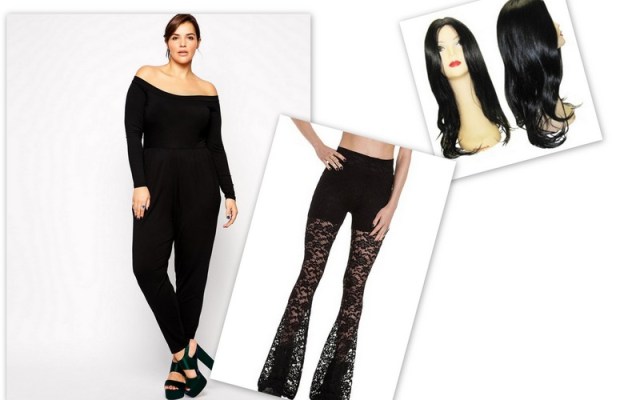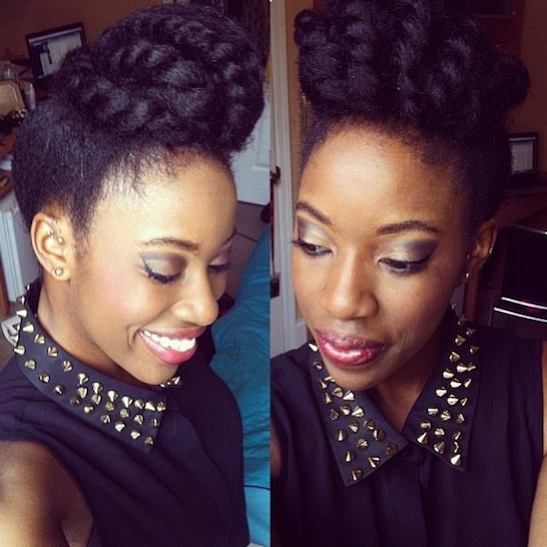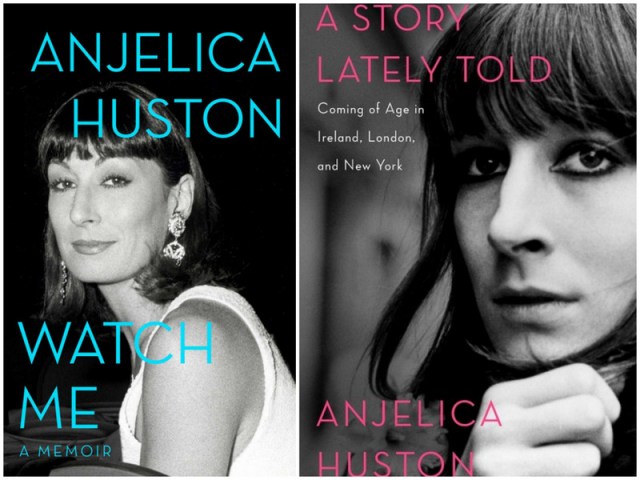On the Front Lines: Alternative Forms of Protesting Police Violence
featime image via BC Art Life
This piece was originally published on 1/20/2015.
George Floyd was murdered on May 25, 2020, and we stand in unequivocal support of the protests and uprisings that have swept the US since that day, and against the unconscionable violence of the police and US state. We can’t continue with business as usual. We will be celebrating Pride as an uprising. This month, Autostraddle is focusing on content related to this struggle, the fight against white supremacy and the fight for Black lives and Black futures. Instead, we’re publishing and re-highlighting work by and for Black queer and trans folks speaking to their experiences living under white supremacy and the carceral state, and work calling white people to material action.
Here at Autostraddle we’ve done a fair amount of coverage of the recent protests swelling around the issue of police violence and systemic racism. We’ve also covered how queer and trans women of color are often both at the center of violence from the police and prison system, and at the same time on the front lines of the protests to stop it. For people who want to see change, we are full, heavy, and undone by the outpouring of support in the streets. We feel as though, perhaps, we are on the brink of revolution. But many of us haven’t been on the literal front lines. Not for lack of rage or revolutionary spirit, but because our advocacy comes in many forms.
A friend of mine, an arts activist who is a theater-maker and who works a low-paying job serving coffee to wealthy fifth avenue suits, was on her way to work when a protester stopped her and demanded to know why she — a woman of color — was not in the streets demanding justice. Her answer? “I have to pay rent.” A luxury for many protesters is having a warm home to return to at the end of the night, a home for which somebody probably pays rent. Speaking of payment, getting arrested often precludes paying a fine, or bail, or having a friend or family member to call who can come pick you up. What if you are homeless, or estranged from family? What if you have a job that would not be patient if you are late or absent because you spent the evening at Central Bookings? What if you are physically unable to attend a protest because you use a wheelchair or otherwise disabled? What if you just don’t want to chant and march through the streets in the bitter cold?
Friends and family have leadingly asked me, “so did you ever go to the protest?” as though if I hadn’t, I was doing a disservice to our race. I know of other POCs who couldn’t bring themselves to protest because the very weight of the perpetual onslaught of depressing headline after depressing headline left them feeling emotionally weak. But I have found that those same people, wracked with guilt, have contributed in their own ways, sometimes unwittingly. After the first few nights of emotionally charged spontaneous protests broke out in New York, Autostraddle’s very own Gabby Rivera organized a Google hangout session for QTPOC Speakeasy members. We expressed our outrage, our exhaustion, as well the humor that might seem inappropriate to an outsider, but which was so very necessary if we were to have enough stamina to face the day. During the hangout, we came to the realization that what Gabby had done for us was community care. She was affecting change by giving others a place to prepare themselves to affect change. That is valuable. It’s not as visible as attending a march. There were no selfies to prove we had been there. But it had tangible value.
Alternative forms of protest are necessary to make activism accessible. Sometimes, they’re even more effective at creating change than a permitted march. Here at Autostraddle, we have heard from readers far and wide who say that the content on this website has given them a sense of community they couldn’t find elsewhere. I mean, not to toot our own horn but that’s freaking incredible! Where better to convene a mass of rad queers than on the web? Where better to plot the revolution? If you are feeling bummed about not being able to, or not wanting to attend a protest or a die-in, you don’t have to be. There are a myriad of ways you can contribute, and you might already be doing it without knowing.
When petition sites like Change.org started popping up, there was a lot of skepticism surrounding the effectiveness of a petition that was just too easy to sign. Long before any of these phenomena, “Facebook activists” were taking advantage of easy access to hundreds and thousands of people to disseminate information from independent and alternative news sources, to the annoyance of some, but the benefit of many.
Now, the positive effects of cyber activism are becoming clear. Petitions on Change.org and other sites have countless success stories. I first heard about the Michael Brown case from a Change.org email. I know many others who received this tragic news the same way. This was amidst the End Stop-and-Frisk campaign taking off in NYC, and I believe the confluence of these two events have inextricably tied Ferguson to New York, even before the police murder of Eric Garner. Something as simple as signing up for an email listserve brought the Michael Brown case to the doorstep of every American, and helped galvanize a nation. Previously, the memory of Michael Brown would have been reduced to a statistic.
Entire revolutions have been facilitated via Twitter and Facebook. American movements have taken a page from their book, using Twitter to locate protests in real-time without alerting the authorities. Other hashtag movements have given a voice to those usually marginalized. For example, the twitter-facilitated movement, #YouOKSis encourages women, especially women of color to be active bystanders in instances of street harassment, and to share those experiences on twitter. Creating a community where women of color know they can rely on others to check in and prevent potentially violent interactions in the street can offer peace of mind to women whose voices are often drowned out by the patriarchy.
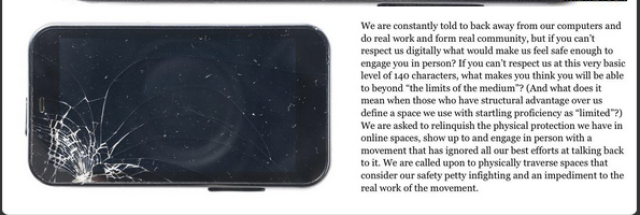
Speaking of creating space, #ThisTweetCalledMyBack recently came to the defense of what has been dubbed “Toxic Twitter.” Toxic Twitter refers to primarily POC women and marginalized communities that have found their voices in the Twitterverse:
We are your unwaged labor in our little corner of the internet that feeds a movement. Hours of teach-ins, hashtags, Twitter chats, video chats and phone calls to create a sustainable narrative and conversation around decolonization and antiblackness. As an online collective of Black, AfroIndigenous, and NDN women, we have created an entire framework with which to understand gender violence and racial hierarchy in a global and U.S. context. In order to do this however, we have had to shake up a few existing narratives…
The response has been sometimes loving, but in most cases we’ve faced nothing but pushback in the form of trolls, stalking. We’ve, at separate turns, been stopped and detained crossing international borders and questioned about our work, been tailed and targeted by police, had our livelihoods threatened with calls to our job, been threatened with rape on Twitter itself, faced triggering PTSD, and trudged the physical burden of all of this abuse. This has all occurred while we see our work take wings and inform an entire movement. A movement that also refuses to make space for us while frequently joining in the naming of us as “Toxic Twitter.” Why do we face barriers at every turn? If you hear many tell it, we are simply lazy women with good internet connections.
In an age where young women often have cell phones with internet access before they have access to healthcare and social services, why are so many so quick to demean the work of digital feminism in the hands of Black women?… When we ask these questions, we uncover that the only people who meet these qualifications of real activism are cis gender, able bodied people — frequently male.
Online activism is controversial, no doubt. “Hacktivism” is often synonymous with the vigilante hacker organization Anonymous, which has achieved many things by threatening to reveal the personal information of their targets. Often these targets are the subjects of high profile controversies, like the Westboro Baptist Church, or members of the KKK. More recently, Iggy Azalea has been the subject of Anonymous’s ire, after she got into a rather sticky (read: racist) twitter argument with Azealia Banks surrounding the issues of cultural appropriation and solidarity with Black people. The group threatened to release leaked sex tape photos and called her a “trashy bitch.” This kind of misogynist and childish behavior begs the question: who deserves privacy? While we all cower in fear of the elusive NSA, we often applaud Anonymous’ threats because they have progressive ends. But is it really progressive to lord over misguided individuals by threatening to distribute pornographic images of them? Vigilantes not associated with Anonymous, but with the same skill-sets have released nude images of famous women, not-so-famous women, and women who have dared to speak out against misogyny or rape culture. Hacking is a powerful weapon, often misused in the wrong hands. But then, what revolutionary tool doesn’t have the capacity to be misused?
Sometimes art can be more engaging and transformative than a rally or march. Sometimes art has the power to affect more minds than a riot. Theatre of the Oppressed (ToO) is a revolutionary form of theater that teaches visual literacy, and gives oppressed people a platform to not only express their grievances, but address them as well. The creator of ToO is Augusto Boal, a Brazilian man who considered this technique a sort of rehearsal for real life. One of the many forms of ToO is a performance called Forum Theatre, in which members of a community act out a play that describes their predicament, with a protagonist, antagonist and supporting characters. The audience is then invited to “intervene” in the action of the play, performing the piece over and over until a solution is developed that can then be acted out in real life. ToO groups in New York City do a version called Legislative Theatre in which actual legislators participate alongside citizens and social justice organizations to develop policies. In May of 2014, Theatre of the Oppressed NYC put together a legislative theatre festival addressing racism and profiling within the criminal justice system, called Can’t Get Right. Spect-actors (as Boal called participatory audience members), were invited to “watch, act and vote” alongside city policy-makers on reforms that would improve quality of life for Black and brown citizens of New York. In no uncertain terms, this is revolutionary: giving people the tools to be the change they wish to see.
I have heard some compare the recent protests to what it felt like to live through the Civil Rights movement. While I can’t personally attest to that, nostalgia for the revolutionary spirit of the Civil Rights era does seem to be in the air. And with it, have come reworked, or brand new protest songs. Remember when Lauryn Hill came out with Black Rage? The AP recently reported on the resurgence of protest songs from the rank and file protesters, poets and songwriters. And then D’Angelo released his album Black Messiah, with a tribute to brothers and sisters in the struggle:
Black Messiah is a hell of a name for an album. It can be easily misunderstood. Many will think it’s about religion. Some will jump to the conclusion that I’m calling myself a Black Messiah. For me, the title is about all of us… It’s about people rising up in Ferguson and in Egypt and in Occupy Wall Street and in every place where a community has had enough and decides to make change happen. It’s not about praising one charismatic leader but celebrating thousands of them.
Hip Hop and Black music have always had a sociopolitical undercurrent, but it does seem that we’re developing a soundtrack for our revolution — and it’s sounding pretty funky.
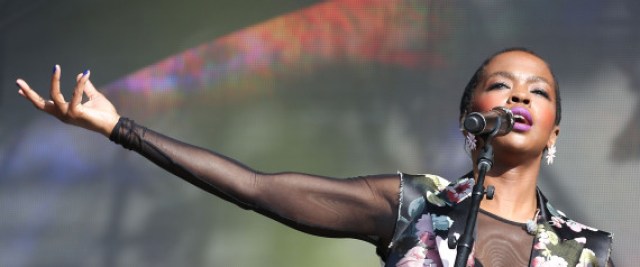
Beyond the web and the stage, there are unlimited ways to contribute our time, energy and money towards a world we would want to raise our kids in. Economic boycotts have been a major part of the anti-police violence movement. Temporarily hindering the economy sends a big message to companies that tend to ignore the plight of the very people they probably employ.
While the alternatives to protest discussed here are by no means all-inclusive, hopefully they’ve inspired you to employ the skills I know you’ve got tucked away in that gorgeous, complicated, infinite brain of yours to do something particular to your interests. If you really don’t know where to begin, Tikkun.org has released a flyer detailing exactly 26 Ways To Be In the Struggle Beyond the Streets. Some of my favorites off the list include providing childcare to protesters, and cooking a pre or post-march meal. Whichever way we choose to participate in this movement, it is important to recognize those who came before us and amplify the voices most often silenced. If we follow those two rules, no form of protest is necessarily more or less valuable than another.
Talking with Reina Gossett and Grace Dunham About Everyday Activism and Why Empathy is Everything
When I met with Reina Gossett and Grace Dunham to talk about activism, the LGBT community and the ways they’re working to change the world, it was immediately obvious how much they love one another: truly, platonically, mutually, completely. The camera isn’t running and Gossett has left the room when I comment on how slickly they finish one another’s sentences. “Well,” says Dunham matter-of-factly, “Reina changed my life.” And this becomes the overarching theme of our conversation: how interpersonal relationships can be more transformative than Big-A Activism. I had heard about their close relationship, and how it was informing some incredible work together, so I sought them out to find out more — over the course of our afternoon together in NYC, our conversation covered everything from the damages of biological essentialism to the radical power of empathy to how important it is to feel sexy sometimes. Though the duo cover every topic from transmisogyny in the lesbian community, to empathy and self-examination, to filmmaking, the major takeaway from our conversation was how interpersonal relationships can be the breeding ground for empathetic, transformative, revolutionary acts of everyday activism.
Grace Dunham (who uses both she/her and they/them pronouns) and I met when we were 12 at St. Ann’s School in Brooklyn. Despite a reputation for whitewashed privilege, a pervy founding headmaster and an extremely competitive college admission process, St. Ann’s is a safe space for strange kids — a unique departure from most of New York’s elite prep schools. Our friendship was shortlived, because as soon as I found my niche of weirdos, I realized Brooklyn Heights wasn’t ready for this jelly, and I bounced on out of private school. Years later, when Grace’s sister Lena created the breakout hit Girls, I found myself wondering what had become of them. Grace had a reputation at St. Ann’s as a phenomenal playwright; their graduation speech had been re-published and circulated for its succinct and impressive rhetoric. Certainly she had a platform from which to project her voice, so why hadn’t we heard from them yet?
And then a whiskey-fueled encounter at a local Bed-Stuy queer haunt, One Last Shag, brought us full circle. There we were, nearly fully realized gay grown-ups: I, a writer for the dopest queer lady publication this side of the Atlantic, and Grace traveling the world to bring awareness to feminist and trans issues. I learned that Grace had been working with The Reina Gossett, the silver-tongued trans activist whose name and work is tossed around feminist and prison abolitionist communities more often than the word “intersectionality.” The duo had been traveling the country, researching, learning and storytelling about the history of cross-dressing laws, transphobia in the queer community, building community through nightlife, all while trying to live authentically as queer friends in the public eye.
I asked if I could talk to Gossett and Dunham about their work, and so a week before Pride, we were three queers on a couch overlooking New York City, home of the Stonewall Riots. In the weeks before our interview, Grace mentioned that their research is partially focused on identifying and critiquing transphobia and transmisogyny in the lesbian community. We know it’s there — the transphobia — but the circles I run in deny it vehemently. I hear about these radfems who make a big stink about excluding AMAB women all the time, but I’ve never met one. As a person who thinks about race and racism a lot, I think it boils down to this: just because you don’t ride around rocking a white sheet, doesn’t mean you aren’t racist. Similarly, just because you don’t go around bashing trans women doesn’t mean you aren’t transmisogynistic. Everyone’s a little bit racist. And we’re homophobic, transphobic and classist, too. Gossett and Dunham are committed to recognizing the ways state violence and oppression move through us, even as (or especially because) we push away from it.
For clarity, the oppression of trans women and AMAB gender-nonconforming people is a symptom of transmisogyny, which occurs at the intersection of transphobia and misogyny. However, Gossett was very clear about why they often choose to use the term “transphobia” in place of or in addition to addressing transmisogyny.
“It’s important to me to say not just transmisogyny but also transphobia,” Gossett said. “The same kind of biological essentialism that says trans women should not be in women’s spaces, or that so comfortably uses biology to define what it means to be a woman, or so comfortably uses unreflective and frankly white supremacist and transphobic ideas of being ‘socialized as a girl or socialized to be a woman,’ so often allows trans men or female assigned trans people to take up space. Why? I think because they are using a biological essentialist understanding of what gender is and… I am just so over it!”
For Reina, transphobia refers to our tendency to discriminate based on outward appearances; a tendency which has reproduced violence in the most horrible and dehumanizing ways possible. The same tendency to privilege what we perceive to be male is the same tendency that devalues what we perceive to be female, all of which is an entirely fabricated social construct. Reina identified one major event as an example of how violence reproduces itself.
“In 1973, for instance, this organization called the Lesbian Feminist Liberation [LFL], was really dealing with a lot of sexism within the ‘Gay Movement.’ And they were like ,’This is not okay, there’s so much sexism and we need to stop this. We need to form our own organization.’ So, at the 1973 Pride, Sylvia Rivera gets on stage and starts talking about the Gay Movement forgetting about trans people in prison — and queer people and gay people in prison. At that same Pride, LFL was handing out pamphlets saying that trans women are a mockery of women — specifically, trans women who are getting any kind of income or have a monetized relationship to being trans. I think that is still deeply rooted, in at least queer communities, and has definitely largely affected my experience.”
“I think that it’s complicated in that visibility doesn’t necessarily in and of itself stop violence from happening.”
A major issue here is visibility. “I think that it’s complicated in that visibility doesn’t necessarily in and of itself stop violence from happening,” says Gossett, a point she has made time and again in public appearances. “In fact visibility can be a big form of violence, and something they don’t get to choose… and not bring with it material or emotional or soulful or energetic positivity or liberation or things that help you live day to day.” This consistent pattern is why so many queers are concerned that the recent marriage equality ruling is actually a major setback for other sexual and racial minorities. For this very reason, Gossett and Dunham are concerned with examining social movements prior to Stonewall; prior to “visibility.”
This idea of queer and trans community pre-Stonewall is a major point of interest in their research, flipping the script on when, where and how LGBTQ activism got its start.
“A lot of our process is just asking the same questions over and over and over again, and getting deeper each time,” says Gossett. “We were in Indiana at the Kinsey archives and we were asking questions about cross-dressing laws and how they were playing out in the 50s before Stonewall… and then we were in LA asking the same questions again; asking people who were creating nightlife spaces or inherited spaces from the 50s [about] the overlap between anti-black racism and cross-dressing transphobia.”
There is this sense that LGBTQ activism began in a vacuum at a gay bar in New York called The Stonewall Inn. And even today, at the height of trans visibility, the media tries to paint the Stonewall riots as a white male-centric movement. This is evidenced by the recent feature film Stonewall, in which gay director Ronald Emmerich attempts to paint “the definitive story of the 1969 Stonewall Riots in New York City for a new generation.” There’s just one problem — the lead character is a fictional amalgam of influential fire-starters represented by a very white, very cis, gay male named Danny Winters (played by actor Jeremy Irvine). But anybody who has bothered to lift a finger to examine this historic moment knows that the Stonewall riots were championed by lesbians and drag queens and kings and trans women of color like Marsha P. Johnson and Sylvia Rivera.
Gossett and Dunham prefer not to expend their energy hollering about the ways in which the patriarchy is presented to us, but rather to create their own spaces to tell the stories that need to be heard. Not a direct response to Stonewall but certainly a healthy alternative, Gossett and her filmmaking partner, Sasha Wortzel, are currently producing a film called Happy Birthday Marsha! about Marsha P. Johnson, Sylvia Rivera and their roles as trans activists before, during and after Stonewall. This version of the Stonewall Riots presents us with an intimate portrait of the two women who were truly at the center of the riots: trans women of color. And though a narrative with this lens is essential to the queer film canon, Dunham and Gossett also seek to highlight the ways in which trans and queer activism was absolutely happening before anybody had heard the words Stonewall.
“Stonewall was every single Friday when you were out there trying to be with your friends and trying to survive, and also trying to have fun, and also trying to get laid… and also trying to wear what you want to wear!”
Dunham and Gossett want us to look outside the west village and find the queers who were existing, truly existing, in other cities and towns across America in the decades before Stonewall was even a glimmer in Marsha Johnson’s sequin bustier. “Stonewall is ‘Stonewall’ — Capital-S STONEWALL — but for a lot of people Stonewall was like every night of their life,” Dunham said. “Stonewall wasn’t just like one thing. Stonewall was every single Friday when you were out there trying to be with your friends and trying to survive, and also trying to have fun, and also trying to get laid… and also trying to wear what you want to wear!” Dunham is referring to the many little movements that took place in a person’s everyday life. Something as simple as wearing a dress outside in the face of strict cross-dressing laws was a form of civil disobedience that sparked many confrontations and riots. One being the Los Angeles Cooper’s Donuts riot of 1959, ten whole years before Stonewall. Another is the 1966 Compton’s Cafeteria Riots in San Francisco. “What does it mean,” asks Dunham, “to not look for the event or the moment or the person that has the capital letter, but to look for the life that’s expansive and doing all of this work that doesn’t get remembered in the way that institutionalized histories and institutionalized success gets remembered?” Gossett and Dunham are trying to live that “expansive life.” And I would say they are succeeding.
Part of the life that’s expansive is about our human connections, the small moments of choosing whether to reach out or push away that make up the emotional network that is the LGBT community. Dunham and Gossett argue that empathy is at the heart of movement building, especially as trans and genderqueer activists in feminist and lesbian communities. “There’s also just so much biological essentialism that it’s really hard to then not take that on myself and then do it to other people, right?” Gossett is explaining the ways in which we reproduce violence onto the communities we believe are holding us back from achieving our activist goals. This includes both other oppressed minorities, as well as privileged individuals we perceive to be oppressors. “That’s why I have so much empathy… like I’m so hurt by transphobia and that’s why it’s so important for me to not assume people’s pronouns and definitely not assume their gender. People walking down the street, we can talk about in all different kinds of ways. We can talk about all the harmful things a person might have done without being like ‘that man, y’know, did this thing… That cisgender man said this to me… It’s really wonderful I think right now to leave space for everyone’s gender self-determination.” The two are really diligent about using self-reflection as a means of identifying harmful aspects of the culture within they participate. Dunham grew up in a liberal ‘supportive’ environment, but still experienced the weight of biological essentialism on her gender expression.
“I so wish that when I had been young there had been adults and mentors and worlds that had welcomed me into a way of understanding myself as queer without enacting biological essentialism onto myself,” Grace said. “I was a little kid who was told I was a girl but who intensely asserted that that’s not who I was. I was like call me Jimmy, get me a leather jacket, I want a babysitter that is on a motorcycle and has a very large beard. And because of the way I was enacting who I was, the thing I got reflected back at me is ‘oh you’re a lesbian,’ not ‘oh, this is a young person who doesn’t feel good about the role they’re being told to inhabit.”
But instead of developing resentment toward the people who assigned Grace’s gender for them, they work toward recognizing that same tendency in their self, and fighting it. “It’s easy as somebody who is consistently read as a white lesbian and as someone who came into my queer identity having a relationship to that history to feel a lot of anger at the ways in which people who came before me enacted these kinds of violence, but I think [it’s better to look] at those moments as an opportunity to think about just how deep the state goes into us and into the ways that we reproduce the state’s violence.”
Okay, so after this self-examination, what are the next steps to building trans-inclusive lesbian and feminist communities? “I think I have this moment with you again and again,” remarks Dunham to Gossett, “where we realize the work we want to do we’re already doing… There’s so much pressure to find the right thing to do, or find the right work to do or do the most impactful most ambitious thing, but chances are you’re already doing it.” Gossett couldn’t agree more.
Activism isn’t necessarily about being at the protest or at the organizing meeting, but about being in a practice. “Having a space to be in a practice where you do it in small ways every day for a while, rather than thinking that it’s outside of you and you have to do some huge thing and organize around it that way. We can do small everyday ways of being fabulous and it’s transformative. Or, small everyday ways of being in a collaboration-slash-friendship.” For example, on July 11th, Dunham and others hosted a reading and party, Summer Nights On Jupiter, at a historic Lower East Side community garden called Le Petit Versailles. The house was packed. Afterwards the stage became an open-mic where audience members were invited to sing and share their own poetry. This on its own was a simultaneous act of celebration and mourning for the pioneers of trans liberation.
“Feeling beautiful, feeling hot, feeling sexy, is getting things done.”
“How are you supposed to get things done if you don’t feel good about yourself?” Dunham proposes, while Gossett counters with, “Feeling beautiful, feeling hot, feeling sexy, is getting things done.” They are, of course, in agreement. “Feeling good is some of the hardest work that we can do,” Dunham says, “You’re not just an activist if you try to change legislation, you’re also doing amazing transformative work if you teach your friend to do her make-up. You’re also doing amazing transformative work if you find a way to go steal some dresses with one another and make sure you don’t get caught so that you have the clothes you need to be who you want to be. That’s what I’m so into right now.” That is the space Dunham and Gossett aim to create.
“It’s actually is really risky to have fun in a way you’ve been told not to… so, we’re starting to work on planning a big costume dress-up party where we’ll have lots of clothes from different decades, different periods, different themes and sets and tons of our friends and young people who maybe have gotten to experiment with the clothing that they like, and maybe haven’t… will have a safe space to go fucking wild.”
How do Dunham and Gossett manage to feel safe when they are so often concerned with making others feel safe? How do they maintain their exuberance and optimism when they are entrenched in the tragedy that appears to be the trans experience in the age of information, visibility, and media corruption? How do they protect their big and open hearts? Grace puts it in terms I can fully understand: “I feel like I really loosely use the term research to talk about what we do together, because a lot of what we do together is just be in a friendship with one another,” Dunham says, unafraid to complicate the terms of their partnership. “We’ve just been doing a lot of storytelling… this is what is sexy to us, this is what inspires us, this is what makes us feel like the world is this magic place.”
One Black Unitard, Three Badass Lady Costumes
Between the ages of seven and eleven, I wore the same store-bought witch dress for my costume every year. By the time I was eleven it was the length of a shirt on me, but I made it work… sort of. I was a witch, a zombie, a fallen angel, and the night sky. The night sky costume consisted of me painting my entire face black and drawing sloppy white stars all over my face with stage make-up. I looked more like the bubonic plague. My enthusiasm for Halloween and crafting my own costumes has not faded, but my technique has definitely improved. And thank goddess, because these days Halloween starts at ComicCon and doesn’t end until everybody has gotten over their post-Halloween Day Parade hangovers. You’ll inevitably have to go to more than one Halloween party and incidentally can’t be caught rocking the same ‘fit at each one! But crafting costumes can get expensive. So, here are four costumes you can pull together using the same basic unitard/romper thing.
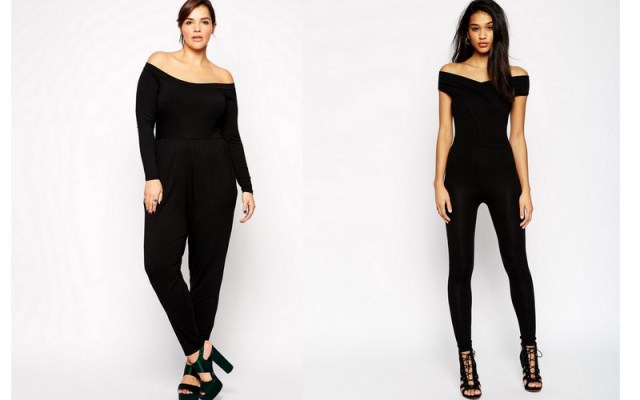
ASOS Curve Exclusive Bardot Jumpsuit on sale for $33.00, ASOS Bodyfit Jumpsuit With Wrap Bardot $44.79
The first one is long-sleeved. If you live in warmer climates, maybe you want to cut the sleeves, but it’s usually cold in my neck of the woods on Halloween, so chances are I’ll be rocking a cardigan that color-coordinates with my costume some way.
When crafting multiple costumes, make-up and accessories are key. They sell the whole dang thing. For all of these looks, you’ll need:
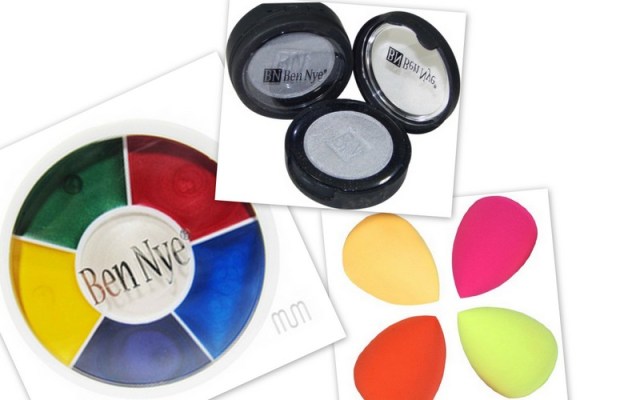
Clockwise from left: Ben Nye Lumiere Creme Wheel $19.99, Ben Nye Lumiere Grande Wheel in Silver $10.99, Set of 4 Teardrop Beauty Make-up Blenders $7.99 — these ones are hypoallergenic.
1. Catwoman
Possibly the easiest of them all. The make-up is entirely up to you, but your upper face will be covered so there’s no need to worry about eye make-up.

Clockwise from bottom left: Balaclava Motorcycle Mask $10.87, 6-foot Braided Leather Bull Whip $9.99, Harlequin Black Eye Mask $4.89. Image via IGN.com
The costume: your jumpsuit, a balaclava over your head, party mask, cat ears. If you’re gonna buy a whip I suggest getting one you’ll actually use again (wink). You could make your own cat ears out of a headband and wire — unless you’re feeling lazy, in which case you can buy them.
2.Ursula
Mey also mentioned this as a potential witchy costume with some outfit ideas, but this version is a bit more DIY. I enjoy going wild with makeup, but if you’re looking for something low-maintenance and easy to throw on, just take some of your silver make-up and brush it along your collarbone, highlight your cheekbones, and maybe create an exaggerated widow’s peak on your forehead. Shade in some of the purple from your color wheel around the edges of your face to give it a little dimension. If you’re looking for a hardcore make-up tutorial I found a pretty incredible one here. But we laywomen want to be able to party all night without ending up with our eyebrows melted into our chins. Throw on some drugstore red lipstick, aquamarine shadow and black liquid liner. Don’t forget her signature mole on the bottom left of your lower lip. Lastly, douse your hair in white hairspray and let it go wild.
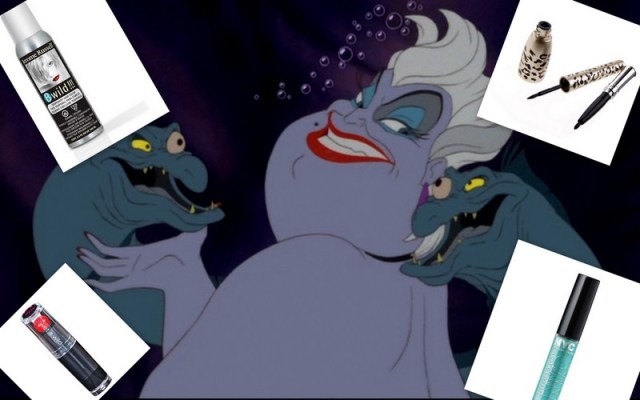
CLockwise from bottom left: Wet N Wild Lipstick in Red Velvet $4.50, Jerome Russell BWild Siberian White Color Spray $8.99, MEXI Makeup Waterproof Leapord Shell Eyeliner Pen $1.99, NYC Color Sparkle Eye Dust in Aquamarine $2.70. Image via Disney Wikia.
This next part you can either sew or just safety pin. Just get yourself three or four pairs of purple pantyhose (depending on whether you think Ursula is a squid or an octopus) and stuff ’em with cotton. Pin those mofos to your body suit and you’re off.
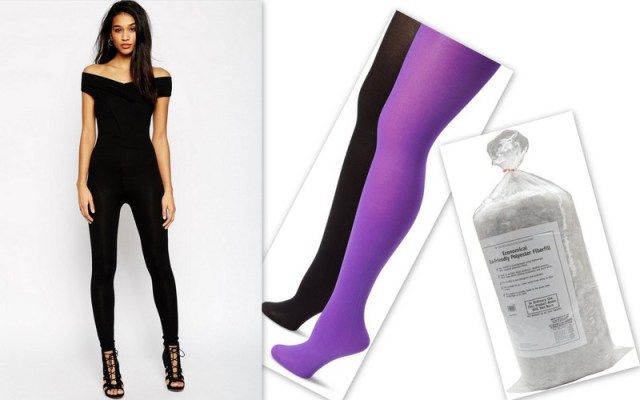
MUSIC LEGS Opaque Solid Tights in Black and Purple $9.00 per pack of 2, Eco-Friendly Recycled Fiberfill $10.87.
3. Morticia Addams
This one is so easy, you guys, I can’t even. Makeup consists of dusting your face ghostly pale, re-applying that same red lipstick, black liner and some smoky eye.

Top Right: Ben Nye Super White Face Powder $7.99, NYX Hot Singles Eye Shadow in Moonrock $4.50. Image via Express UK
So assuming you don’t own a black bell-sleeved shirt, how do you get those bell sleeves without purchasing a whole new dress? Make them out of pants! Just take those crazy festive bell-bottom leggings, cut the legs off and shove them on your arms. Ba-da bing, ba-da boom.

Don’t worry, Morticia ma belle, Halloween is basically an entire month long.
20 Recipes That Were Perfectly Healthy Until Bacon and Butter Came Along
Hello and welcome to this thing we’re doing where we help you figure out what you’re gonna put in your mouth this week. Some of these are recipes we’ve tried, some of these are recipes we’re looking forward to trying, all of them are fucking delicious. Tell us what you want to put in your piehole or suggest your own recipes, and we’ll talk about which things we made, which things we loved, and which things have changed us irreversibly as people. Last week, we ate figs.
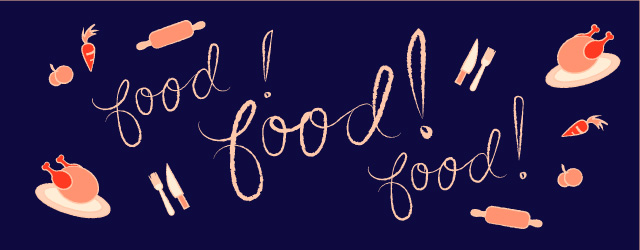
So after thirteen years of vegetarianism and an abrupt realization of my digestive issues, I had to cut bread and dairy out of my life forever. In lieu of something like a log of goat cheese and a baguette for dinner, I turned back to red meat, namely bacon, and quite a lot of it. Turns out red meat isn’t so great on the stomach either, but I discovered that being a carnivore really suits me. Actually, if I pretend hard enough that butter isn’t made from milk, I can imagine that my insides aren’t turning against me. So, in honor of my inability to maintain a healthy diet, here are 20 recipes that were perfectly healthy until they were blessed by bacon and/or butter.
1.Bacon Wrapped Avocado Fries
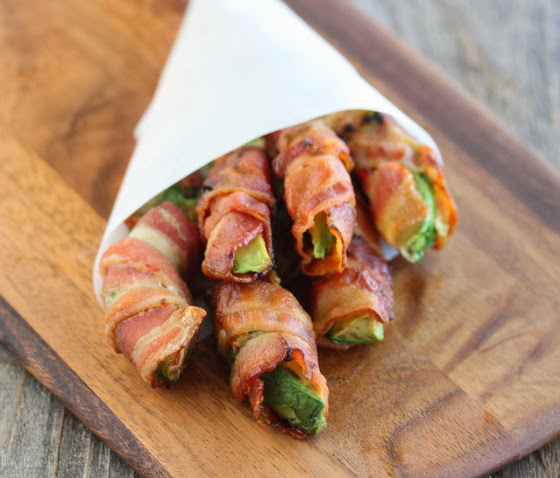
2.Sweet Potato bites with Avocado and Bacon (Paleo and Gluten Free)
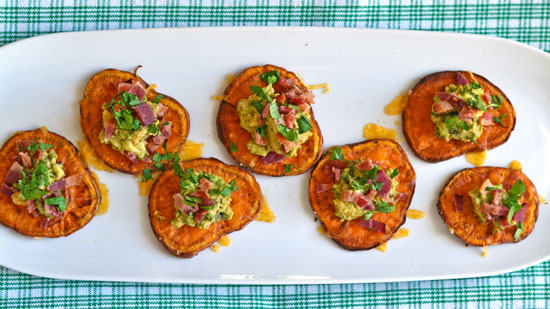
Because avocado balances out the unhealthy stuff.
3.Bacon Wrapped Bananas

Jeez can you imagine if you used sweet plantains instead? Can you imagine?
4.BLT Salad
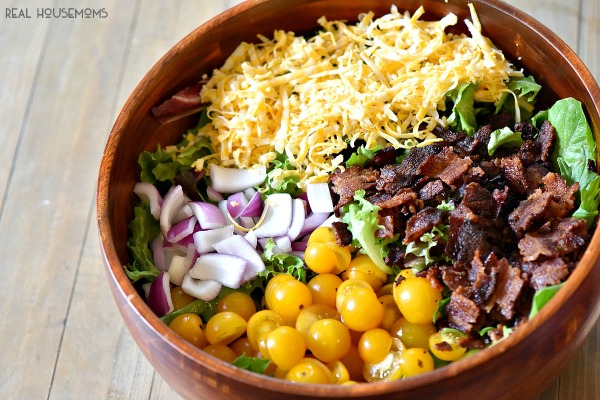
Recently realized that if you add mayonnaise to any cold meat it automatically makes it a salad. Really complicates my whole outlook on healthy eating.
5.Bacon and Brussel Sprout Hash

This recipe was written for people following something called the KetoDiet. I dunno about all that, but this looks unbelievable.
6.Bacon Wrapped Dates with Balsamic Reduction
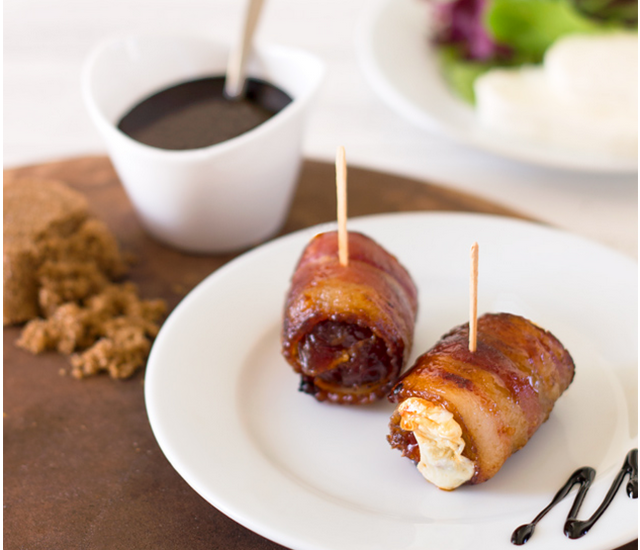
Classique.
7.Best Potato Salad
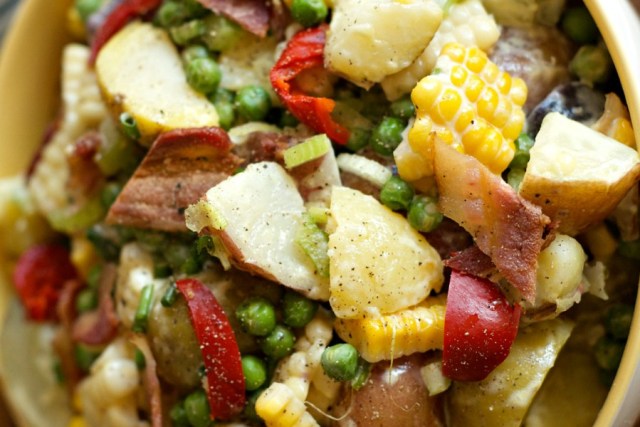
Is this real life?
8.Butter and Milk Boiled Corn

I want to kiss the person who invented this recipe. This is mad genius.
9.Homemade Honey Butter
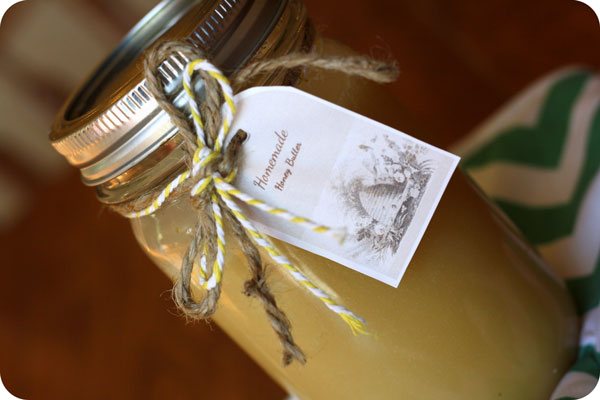
Because as far as I’m concerned honey is a health food.
10.Bacon Roasted Corn

Is this taking it too far? One way to find out.
11.Bacon Jalapeño Deviled Eggs
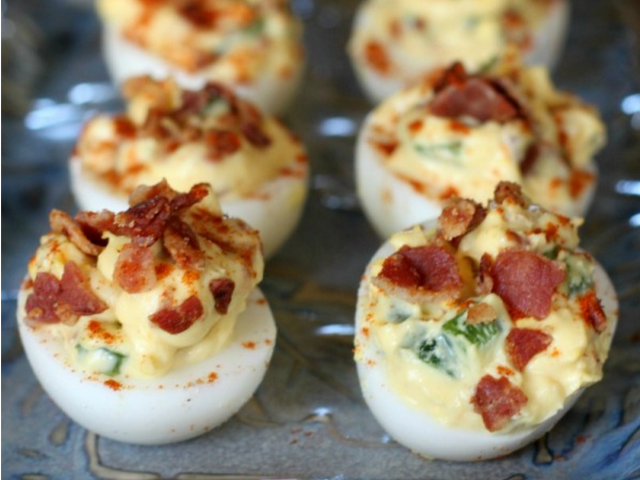
Putting the devil in deviled eggs.
12.Cheesy Bacon Hassleback Zucchini
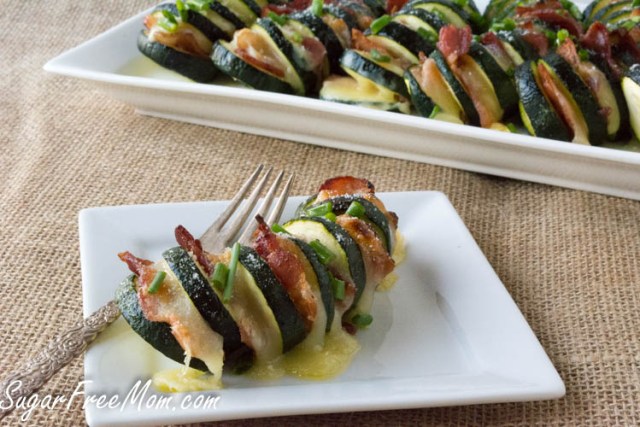
13.Bacon Wrapped Grilled Peaches with Balsamic Glaze
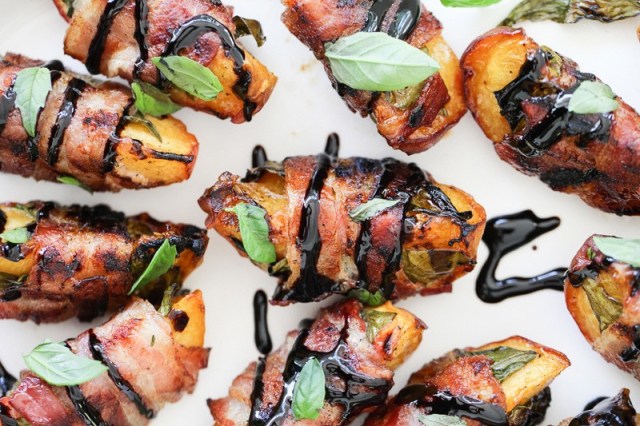
Of all the foods one could wrap in a smoky blanket of bacon, how id I not think of this before this foodie blog did?
14.Prosciutto Wrapped Asparagus

Prosciutto, bacon’s suave european cousin.
15.Strawberry Poppy Bacon Chopped Salad
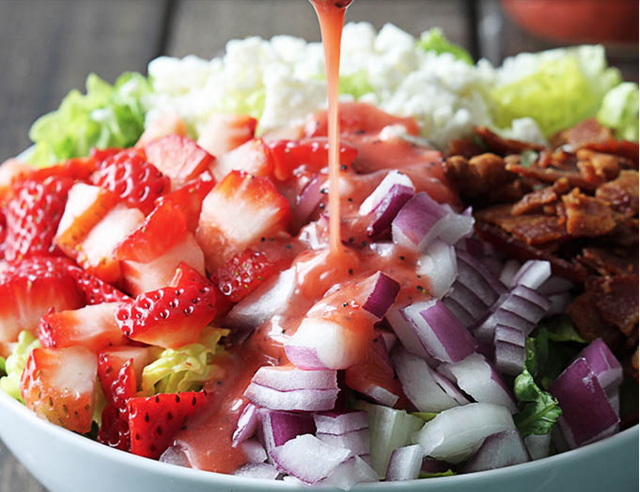
16.Broccoli Salad with Bacon

Forget cheesy broccoli, bacon is the new cheddah.
17.Blackberry, Bacon and Blue Cheese Salad
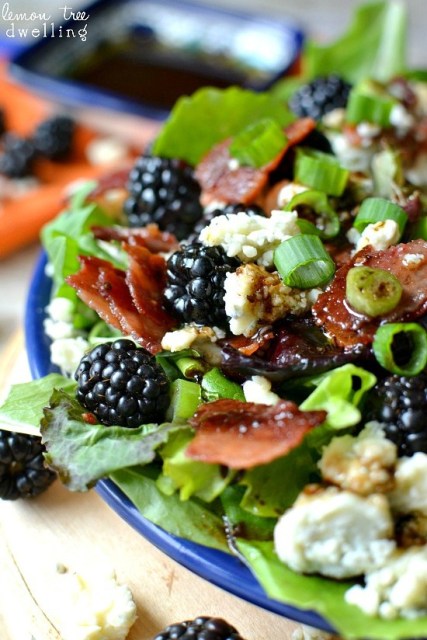
When in doubt, alliterate.
18.Quinoa and Kale Salad with Avocados, Apples and Bacon
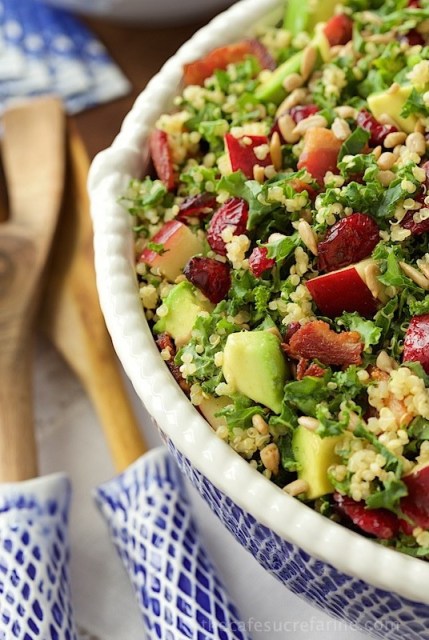
I think this is actually still genuinely good for you.
19.Spring Quinoa Salad with Honey Lemon Vinaigrette
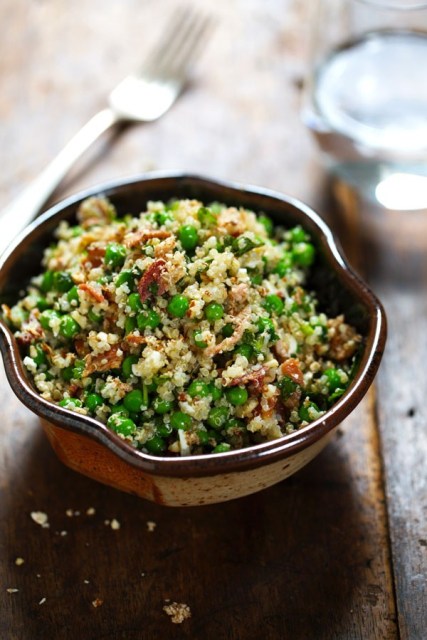
It’s not in the title but I promise it does have bacon. And peas! I seriously adore fresh peas. So damn cute!
20.Bacon and Brown Sugar Roasted Sweet Potato Salad

Personally there is way too much cooking involved to call this a salad.
Queer New York Fashion Week: A Parade of Bold Ideas and Fresh Faces
by Hannah and Aja
Inarguably the most inclusive and supportive fashion show to come out of NYFW, VERGE: Queer New York Fashion Week at the Brooklyn Museum was a parade of fresh ideas, fresh faces, and queer community. With the stunning Beaux-Arts Court at the Brooklyn Museum as its backdrop, eight queer designers donned their queer, trans, fat, brown and disabled models in an exclusive first look at this season’s boldest, brightest, queerest and most dapper Spring/Summer collections.
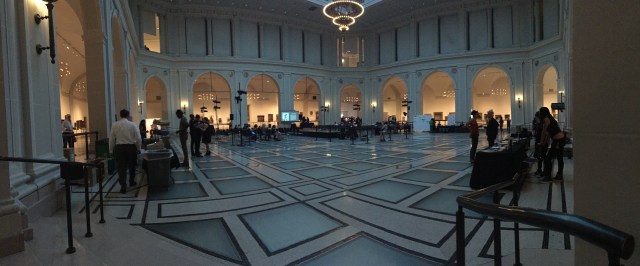
Beaux-Arts Hall at the Brooklyn Museum. Photo by Hannah Hodson.
I went behind the scenes to catch the organized mayhem that breathes life into New York’s largest queer fashion week event. Backstage, models carved a nook out of the chaos to get all gussied up in designs by Sun Sun, Not Equal by Fabio Costa, KQK by Karen Quirion, LACTIC, Fony, MARKANTOINE, SAGA by Sandra Gagalo, and Jag & Co..
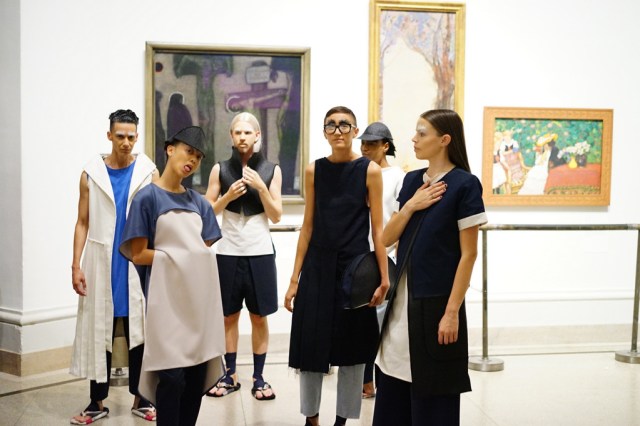
Models wait their turn to walk the runway for Not Equal. Photo via Fit For A Femme
There were some big names on and off the runway. Verge highlighted some of these models in a press release:
Over 70 models who challenge traditional gender constructs took center stage, including celebrity models Rain Dove (the most cast female model during the inaugural Men’s NYFW) and Ryley Rubin Pogensky (one of 17 trans-identified models in the groundbreaking Barneys New York ad campaign shot by Bruce Weber.) Melanie Gaydos, as well as Prince Harvey, the hip hop artist who secretly recorded an album at an Apple store, were just some of the many other prominent models who dominated the runway.
In attendance were singer/designer Margeaux Simms, and androgynous models Elliott Sailors and Harmony Boucher.

Ali Medina backstage before walking for KQK. photo by Hannah Hodson

Models prepare to walk for Jag and Co. Image via Fit For A Femme
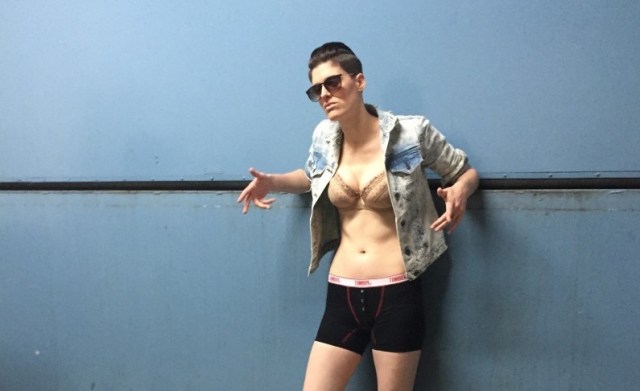
Rain Dove backstage at VERGE. Photo by Hannah Hodson
But the true stars were the team behind the production, one of whom was Autostraddle Beauty Editor and Fit For A Femme blogger Aja Aguirre working the runway visuals. The people at Colette Lee Productions managed the runway and provided the hair and makeup team. Producers for the event included Van Bailey and Zahyr Lauren from bklyn boihood, Winter Mendelson and Christiane Nickel from Posture Magazine, and Dina Habib and Danik Yopp from Montreal based D.Y.D.H Productions.
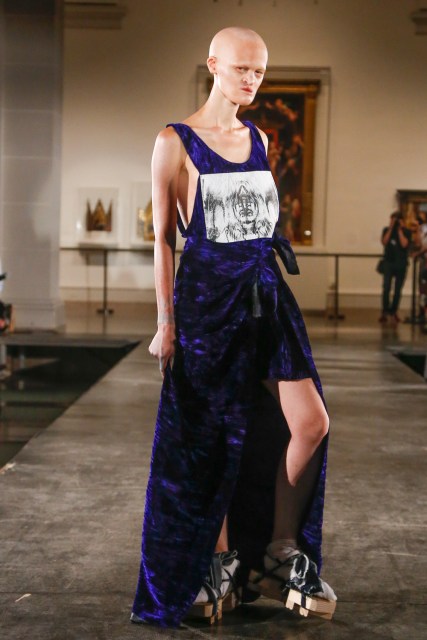
Melanie walked for SAGA NYC. Photo by Katya Moorman/Karen L. Dunn
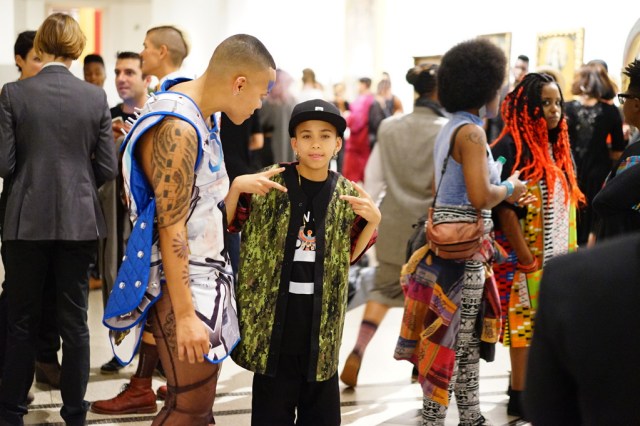
Krishna, 11, walked for Sun Sun. Image via Fit For A Femme
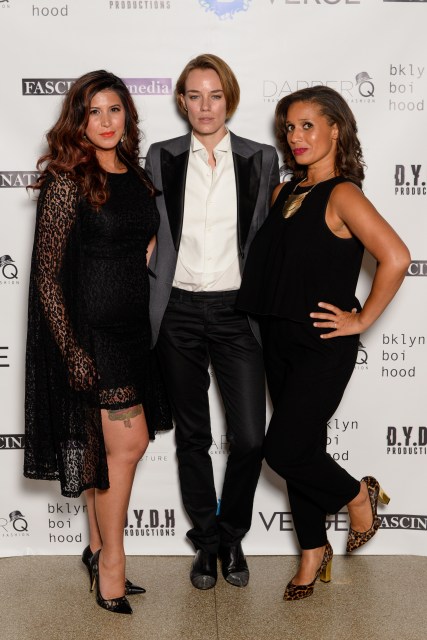
Aja Aguirre, Elliot Sailors and Anita Dolce Vita. Photo by Alyssa Meadows
Last and most certainly not least, Anita Dolce Vita and Dez Irani at DapperQ, the brains behind the whole operation, worked day and night to make sure the event was highly accessible (the Brooklyn Museum asks for a suggested donation but won’t turn anybody down due to lack of funds) and highly entertaining, with “How-To” stations doing cat-eye and glitter lip make-overs run by Aurora Wells and Sonam Chandna.
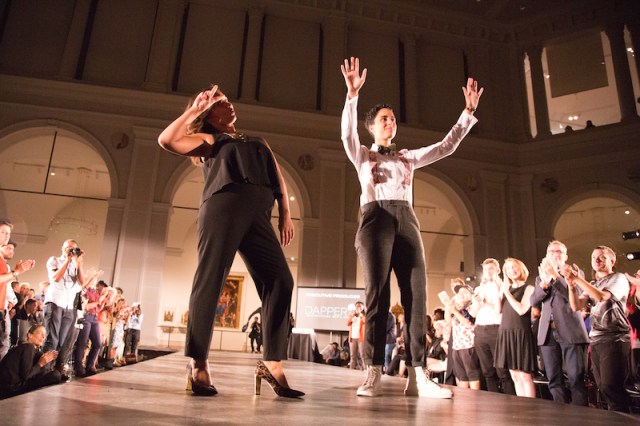
Anita Dolce Vita (left) and Dez Irani (right) take a bow to raucus applause after thursday night’s show. Photo by Oscar Diaz
And did you know that Ms. Dolce Vita is a full-time nurse? On top of working tirelessly to bring inclusive queer fashion to the forefront, Dolce Vita spends her days healing people. The same might be said for what DapperQ does for queer, trans and gender nonconforming folks. The ability to live authentically by wearing the clothing that feels true to your gender can be life-changing and even life saving for some folks. Dolce Vita says she uses a lot of her nursing skills to pull off fashion shows:
“Assess, triage, delegate,” she says. “Many people think that fashion shows are easy to produce. They are complete chaos behind the scenes. I utilize many of my nursing skills to make it all come together so that none of this chaos spills over on stage, whether it be coming up with a creative solution to fix a ripped garment on a model minutes before showtime, or troubleshooting glitches in a designer’s music.”
Even though VERGE was not an official IMG Fashion Week event, Dolce Vita says it was included on the CFDA calendar, and that it was crucial this show be seen as professional and as much a part of Fashion Week as any other event: “NYFW is such an staple event for our city and is one of the world’s major fashion weeks. We feel that the LGBTQ community should have a voice in, and be a part of, NYFW considering how mainstream fashion is co-opting our style but not providing space for all bodies to exist in fashion.” VERGE was a one-time collaboration between DapperQ and its producers, but DapperQ has been hosting standalone shows at places like the California Academy of Sciences and Brooklyn Museum since 2013. Last December, DapperQ presented (un)Heeled at the Brooklyn Museum to great fanfare.
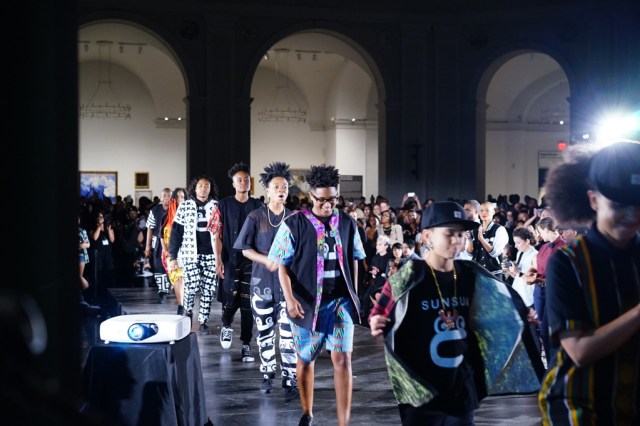
Models take their final waltz after walking for the Sun Sun. Photo via Fit For A Femme.

models for LACTIC, the evenings most outlandish line, make their final rounds. Image via Fit For A Femme.
To be perfectly honest, Queer Fashion Week is the only kind of Fashion Week I want to be at; community-creating, gender-affirming, body positive, anti-racist feminist fashion week. Yes, please.
“Addicted to Fresno” Is Your Next Favorite Movie from Jamie Babbit and Natasha Lyonne
Director Jamie Babbit, who brought Natasha Lyonne down from the heavens and delivered us But I’m A Cheerleader has once again bestowed upon the lady-loving community a dark and twisted comedy: Addicted to Fresno. At once completely deranged and oddly sweet, Fresno follows two sisters in a codependent relationship in which Martha (Natasha Lyonne) habitually picks up the pieces behind recovering sex addict Shannon (Judy Greer). And in case you were wondering, yes, Lyonne plays a lesbian.

images courtesy of MPRM Entertainment
The film premiered on September 3rd at the SVA theater in New York as part of NewFest, in partnership with OutFest and the Film Society of Lincoln Center. The screening of this particular film kicked off an effort to showcase more films by queer women. While queer women are certainly represented on screen, it’s really the brains behind the whole outfit that make the film uniquely suited for this mission. Babbit’s wife, Karey Dornetto, wrote the screenplay.
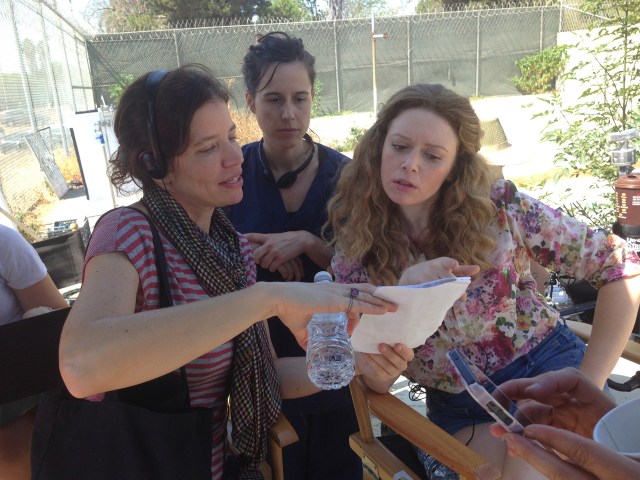
Jamie Babbit (left), Karey Dornetto (center), and Natasha Lyonne (right) behind the scenes. image via MPRM Entertainment
Both Babbit and Dornetto have established themselves in the industry without pigeonholing themselves as queer artists. Babbit directed eighteen episodes of Gilmore Girls; Dornetto started out as a staff writer for South Park. It is precisely because of their diverse and varied resumes that the writing and direction of the queer relationship in this movie is just so perfectly NBD. There’s nothing sensational or special about the courtship between Martha and her wry karate instructor, Kelly (Aubrey Plaza). It’s just as awkward and confusing as any other dating-your-physical-trainer scenario might be. Okay, there is that one scene with all the lesbian softball players fondling massive purple dildos. That did happen.
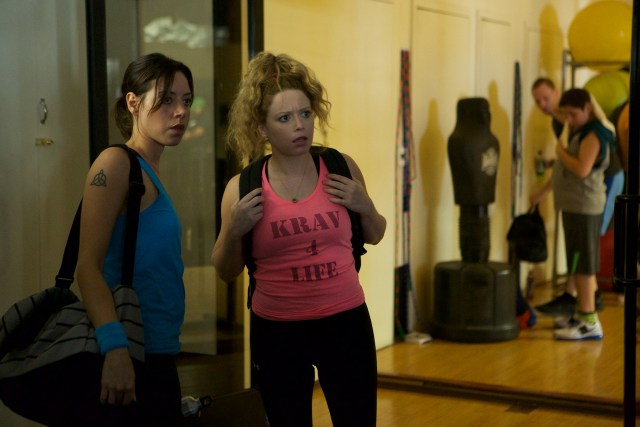
image via MPRM Entertainment
Fresno is a perfect example of how women are an underappreciated and untapped source of cutting edge talent. Sure, the dick jokes abound, but I can’t remember the last time I heard a dick joke that was actually funny until I saw this movie. Given the opportunity, women can make (and are making) indie content with mainstream appeal. At the Q&A after the September 3rd screening, Jamie Babbit made certain to thank Gamechanger Films, which finances woman-directed films in an effort to close the gender gap in filmmaking. An admirable mission, and one that brought us this spunky little gem.
A murder, Fred Armisen, a bar mitzvah and Molly Shannon. What more can I say? The movie is a barrel of laughs, and the cast is chock full of comedy royalty. After what feels like a marathon of raunchy humor and aggressively casual sex, the film has some trouble tying up its loose ends, but it’s well worth the ride. You can download Addicted to Fresno on iTunes, stream or rent it on Amazon, or catch it in theaters beginning October 2nd.
Watch Beth Malone Figure Out She’s a Lesbian In Her One-Woman Show “So Far” at Joe’s Pub
Luther Ingram, Jodie Foster, Kristi McNichol, and Connie Chung all play crucial cameos in Beth Malone’s So Far, and that’s all in the first fifteen minutes. The Fun Home star returned to her roots at Joe’s Pub at the Public Theater in New York City on August 31st to perform a one-woman cabaret show following a rural lesbian through her tomboy childhood, an engagement (to a man!), her first stint as an actress in New York, another marriage (to a woman!), and her ever-tense relationship with her Colorado cowboy father.
Malone is slight in stature, but commands the stage with epic confidence, opening the act with Luther Ingram’s “If Lovin’ You Is Wrong (I Don’t Wanna Be Right)” — a song I didn’t know was so gay until Malone sang it. Her wit is biting, her story relatable, and her voice is like an angel’s. Using the storytelling aid of paper-plate puppets of Jodie Foster, Kristi McNichol and Connie Chung, we are transported through the countless childhood “aha” moments that should have led Malone to realize she was a big, fat, bleepin’ lesbian, but which only served to leave her confused into early adulthood.
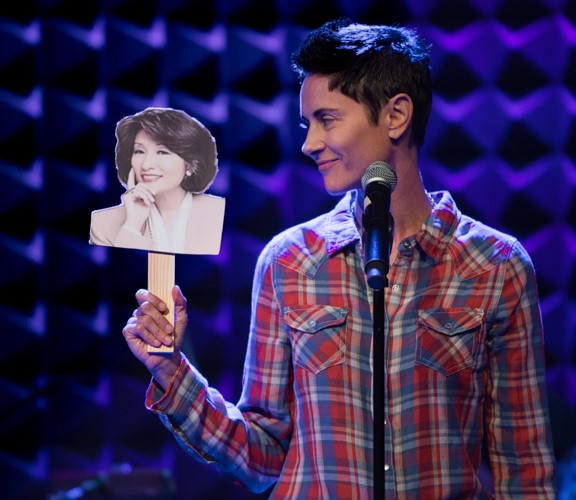
photography by Kevin Yatarola
Though it takes Malone until she’s already promised to a man to finally sleep with a woman for the first time and fully realize her lesbianism, her awkward and uncertain stumble toward this conclusion is one most queer women will recognize. A smaller (though, I imagine, still quite large) contingent will relate to her tragic and estranged relationship with her right-wing, Rush Limbaugh-enthusiast father, with whom she was once inseparable.
Malone tells us about getting an on-stage kiss from Barbara Mandrell at eleven — “on the LIPS!!!” — exchanging Christmas gifts with her mother in a parking lot, and getting type-casted on the New York musical theater scene: “‘Scrappy’ is a euphemism.”
With impeccable comedic timing and an ear for the queer in almost every musical genre, Malone is able to process in one show what many people are unable to process ever in their lives. It’s a lot. So much, in fact, that we are rewarded with a short reprieve from all the feelings with a mid-show interactive theatrical break called “Ask a Lesbian a Question,” during which Malone and Fun Home book writer Lisa Kron answer the audience’s most pressing questions as can only two very sarcastic lesbians can. When asked by a gay man about lesbian “labels,” Kron says she self-identifies as a “femme, top, coupon-cutting, childless MILF.”
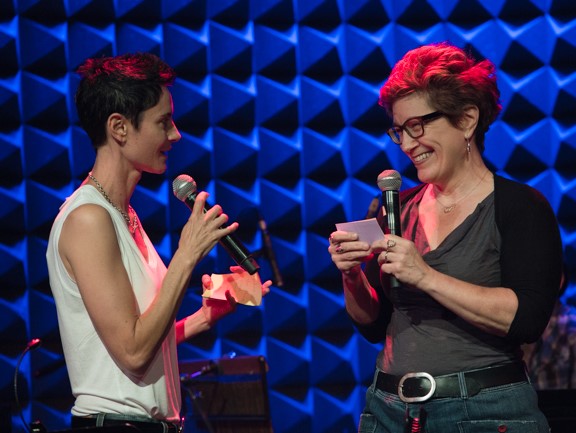
Lisa Kron and Beth Malone argue over whose cats are the cutest photography by Kevin Yatarola
So Far was written by Beth Malone and Patricia Cotter. Musical direction is by Susan Drausstrong and directed by Peter Schneider. The show is produced by LezCab, whose mission is to “create an accurate and meaningful representation of queer women in order to foster equality and community.” They accomplish this task through the magic of theater. They also host social networking events for queer women in the theater, which can be found on their events page.
Melancholia In The Sunshine
feature image via shutterstock.com
I’m trying to build a metaphor around a patch of dirt I like to call a backyard. My boyfriend has this little area behind his house. After two years of watching the neighborhood use it for an illegal dumping ground, we decided to make something out of it. We emptied some left-behind planters of sulfuric sludge, cleared away cinderblocks and an insulating layer of cigarette butts and started to make something green from something grey. We dragged some trash out, dragged some back in (like two grills that lean precariously on a leg and a wheel). We set out a card table, turned over some leftover lumber onto some leftover paint buckets to make benches — y’know, really classed the joint up.
We’re trying to plant wildflowers amongst the weeds, but this soil is rubble.
I’m sitting here with a nice cold cider and my laptop. There isn’t a cloud in the sky. I should be happy — ecstatic even — but there is a distinct sense of melancholia that shrouds me. This happens every summer, and what makes it worse is that I can never identify from whence it comes.
I am, for all intents and purposes, a very happy person. I enjoy all manner of privileges and good things, some of which I worked very hard to achieve, and many others I happened upon by chance. I have two jobs I love very much, and which allow me to express myself creatively without much censorship. I do not suffer from clinical depression as far as I know, though it does run in the family. What I’m saying is, I guess, I got life.
It didn’t seem so hard when we first started, but tending to damaged roots is a slow and delicate process they want us to handle with care.
Don’t you ever want to take a sledgehammer to the whole damn place? Douse it in kerosene and watch it fucking burn? I like to think a tree might rise from those ashes; it probably isn’t a risk worth taking.
I like to blame my morose tendencies on the weather. In the winter, it is easy to say you’re just not feeling well because it’s fucking frigid and who can be happy under those conditions? But that kind of sadness has a name: seasonal depression. You’re sad because it sucks out. You’re sad because you can’t see the people you love as often because it sucks out. You’re sad because you can’t go running around in your skivvies because it sucks out. You’re sad because you haven’t seen a tree that doesn’t look like it wants to commit suicide since September. It isn’t until the summer, when the frost melts and the icee man comes calling and the pool is open and the yard (however ridden with stubborn weeds) starts to incubate natural life, that you realize the source of your woes isn’t dependent on the weather. It’s you. Or it’s me. I don’t mean to project.
So we excavate this rubble that cannot and will not give life. You find a dead rat while you’re raking the yard and you pretend to throw it at me. I yell at you because that is so incredibly disgusting. And you look at me like you didn’t know I would get so upset about something so small. But I am, and here we are, in this yard full of weeds.
I’ve been in a relationship with a man for over three years now, which is at least three years longer than any other relationship with any other person, male, female or otherwise that I have ever sustained. This is the Big One. I have always been the reason something goes wrong. I become restless, or anxious, or needy, or just batshit crazy. And it always seems to happen about right now, when the weeds start to show green in his little patch of dirt.
Last summer, I told him I wanted to see other people. Specifically, that I wanted to start seeing women, that this was a huge part of who I am, and that maybe non-monogamy was equally a part of who I am. So, we took a little break. I will be the first to admit that it was a selfish albeit necessary move for the both of us.
Past relationships have always been a product of convenience, emotionally or geographically or both. They ran their course and didn’t need much help because once they were over there was no question as to whether they would ever return. But, because it seems plausible that this boy might be the person with whom I spend the rest of my life, I have to start counting my blessings; I have to start planting seeds, the kind that will grow back next year and the year after that. Our little break was one kind of seed. Our open relationship is another. I’m hoping that that the way I manifest happiness in my life is by creating new things with my friends, lovers, and family.
We’ll have to take it slow I guess. Pull some weeds. Lay some soil. In the meantime we’ve got this tomato plant we’re growing in a big fat plastic pot, painted the color of terra cotta, that we found beneath some cinderblocks that smelled like piss. And for now we’re gonna stick it right in the sun. Already the leaves smell spicy and green. There is a little promise of something plump and red. I’ll try to nurture something that tastes and smells and looks as fine as you do.
A garden needs constant tending. It needs biodiversity. Those things can be hard to find in a city like New York. It seems as though everything you try to grow is vulnerable to elements out of your control: flash floods, vermin, alley cats. The summer heat brings every threat to the surface. So you trim and weed and build trellises and cages. And still one day you wake up, and a rat has burrowed a hole in your basil plants.
Much like a garden, a relationship needs tending, especially one vulnerable to predators. So when you show up at your boyfriend’s house at 4 am because you can’t sleep, creep through the 1×1 hole in the basement wall, hoping to tuck yourself under him arms so that he will wake up wrapped up in you, only to find that he has spent the night in Taylor’s bed, it’s important to remind yourself that you are not despairing because you are unloved, just temporarily lonely. True love manifest itself in tinier, more complex ways — like the look on his face when he comes home later that day, and sees you’ve been waiting for him, naked and drooling on the pillow and he assures you that you are his number one priority and he should have told you he wouldn’t be home last night. There is a feeling when you learn a new thing about yourself and the person you love; the feeling that you have built something solid. This is what staves off the sadness.
I had this dream we woke up at dawn, and the morning glories had wound themselves around the whole yard. They spun around barbed wire fence toppers and made a bed of themselves down the whole block, creeped through the doorways of the Louis Armstrong Projects and made everything smell so… crisp. They circled the elbows of your other lover’s freckled arms. They pulled at the orange red tendrils of my own. And nobody was awake to see it but you, me and the sparrows.
Building a relationship does not preclude exploring others. Learning what you love and hate about the bodies and behaviors of other people writes an encyclopedia of human nature that helps you understand how you can manage to love the sum of one human’s parts more than any individual part of any other person you have ever known. There’s no formula for this. Feelings will be hurt. Mysterious tiny animals will eat your tomatoes. It will feel like a crazy, impossible, futile thing to do. But, when September rolls around and you know you both put in good, hard work instead of letting the melancholia creep its way inside of you you, the impending task of staying warm in the winter doesn’t seem so daunting.
This is the first summer of my adult life that I have not tried to leave a relationship; the first time I feel like I have the tools to tend a garden.
This Shit Rules: Damage Control
“This Shit Rules” is a beauty column where staff people list the items they can’t live without – the makeup, beauty products, and other shit we use every morning, before we go to bed, or in the car on the way to work.
Once every few years, I get tired of dealing with my curls. A little blow-out can give me a break from the fussing and futzing with out-of-place corkscrews or lopsided bed-head. So I took a little trip to my local Dominican salon to get a wash n’ blow. Now, I’m normally very, very, very particular about what I put in my hair, but I’ve had my hair blown out at this Dominican salon before, and I figured one little shampoo and condition with Suave or whatever they use couldn’t hurt. Whoo boy was I wrong. When the lady was done wrapping up my newly straightened locks I could not believe how incredibly straight she got it to look. Nobody has ever gotten my hair to be so damn straight and silky. It wasn’t until all of my hair was falling out in the shower a week later that I realized something had gone horribly awry.
A hairstylist friend informed me that they must have put a keratin treatment in the conditioner, which, when used with heat, bonds to the hair and basically murders it. Looks great straight, looks like straw when you wash it out. I was mortified. I immediately ran to Ricky’s to stock up on every organic deep conditioning treatment they had on the shelves. In the name of protecting your hair from damage and your pockets from the exorbitant sums of cash I spent trying to find the perfect product, here are the four that actually worked. All of the products listed here are free from parabens and sulfates, which are apparently very bad for curly hair or at least my stylist says so and that’s good enough for me.
Carol’s Daughter Monoi Oil Repairing Conditioner
I really couldn’t tell you what monoi oil is, but I like to imagine it is suckled from the nipples of woodland nymphs, because more than anything else I used, this conditioner got my hair feeling better than normal right quick. They also make a deep conditioner and a leave-in solution, but given how effective just this one product is, and the steep cost, I’d say skip the other stuff. And? It smells like dewdrops and rainbows.

image via Curlmart
DevaCurl Heaven in Hair
I never realized how much this shit rules until I really needed it. If you’re dealing with really terrible damage and need some extra help taming your rats nest, I wholeheartedly endorse this product. All of the Deva products are high quality, but they are also mega expensive (as are most products marketed toward curly-haired and “ethnic” women, but that’s another article for another time). Get a small 8oz. tub for occasional emergencies and try not to break it out unless you really need it.
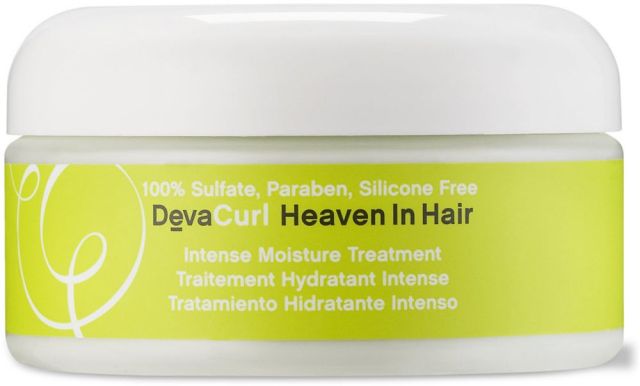
image via Ulta
Shea Moisture Curl Enhancing Smoothie
Once you’re out of the shower and you’ve glooped your hair full of enough moisturizers to re-hydrate the state of California, you can squeeze the water out of your hair and run some of this stuff through it. Of all the leave-ins in all the land, this is the least “crunchy,” meaning that when your hair dries it won’t feel like it’s encased in a layer of ice. The coconut hibiscus smell is a little too saccharine for my taste but it doesn’t stop me from using this product every. single. day.
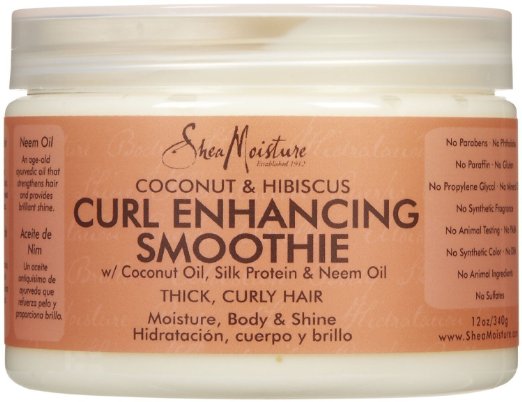
image via Amazon
Carol’s Daughter Mimosa Hair Honey
This one isn’t for everybody. It smells so amazing you might be tempted to dump the whole canister on your head but BEWARE! It scoops out like a pomade, but then sort of melts onto your hair as it dries. It is very very oily. I recommend it only to smooth frizz and add a little extra shine on days when your hair is feeling extra dry or damaged. Try to keep it away from your hairline. Also you may find yourself trailed by a rabble of bees. This has literally happened to me a lot of times and I honestly don’t know what to do about it.
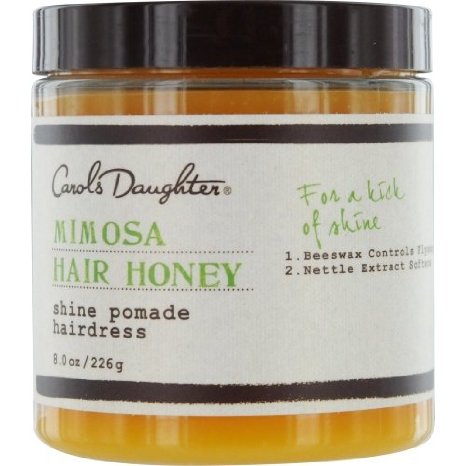
image via Amazon
Party of Five: Nikki Levy of “Don’t Tell My Mother!”
Party of Five is a quick little ditty where we ask someone (anyone we want) five questions (any five questions we want) and they answer them. This doesn’t have to be necessarily ‘queer’ — it doesn’t have to be anything at all, except five questions and five answers.
Nikki Levy is a Los Angeles-based lesbian and film executive who developed the brilliant and heartachingly funny storytelling series Don’t Tell My Mother! The show (which, duh, is available as a podcast) features actors, stand-ups, and performers such as Tracee Ellis Ross, Fortune Feimster, and Kate McKinnon (the list goes on), telling stories they would never want their mother to hear. Though not explicitly a queer performance, many of the stories are super gay. As queer storytellers ourselves, we jumped at the opportunity to pick Levy’s brain before her next performance in Los Angeles on March 26th.
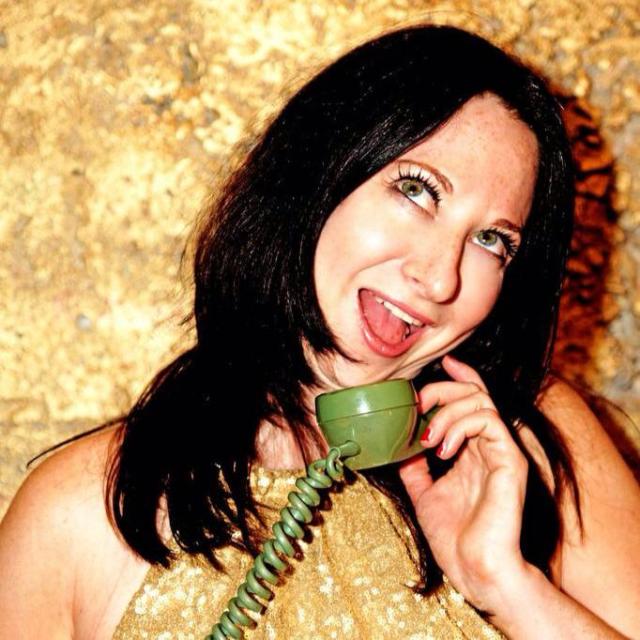
Nikki Levy, courtesy of Nikki Levy
What inspired you to start doing this podcast?
Nikki Levy: I’ve been a development executive in Hollywood for a long time. What that means is that I develop movie ideas with writers based on pitches, books, scripts, plays, etc. As an exec, I’m supposed to be “the suit” in the room working with “the artist.” Though I look pretty fabulous in a suit (see exhibit A, ladies), I am not one! Oh my G-D, I am so not.
I’m a Jew from New York with an eccentric scientist mother, I’ve never been one to follow the rules. As a matter if fact, I’ve been told my entire life by bosses, teachers and camp counselors that I needed to “settle down.” They said I was “too much,” “too loud,” “too inappropriate.” The idea being that I should keep it small – you know “less is more.”
So I tried that, specifically at work: to be quieter, more reserved, less obtrusive. But that meant I was less of myself. And that felt more awful than being told I was too much. As my teacher Alexandra Billings (who plays Davina in Transparent) says, “Less is not more. Less is always less.” And you know what, I didn’t want to be less.
If I was too much for certain places, I was going to create a place where it was wonderful to be exactly me. And for you to be 100% you – weird, honest, joyful, strange, excited, vulnerable and real. All the time.
I started the Don’t Tell My Mother! show and podcast as a place where we could relish in our collective dysfunction.
Which story, so far, has been your favorite?
There are tons of stories I like, but my favorite is told by one of the best standup comics in the business – Jen Kober, a lesbian from Louisiana. Jen came to me through her manager, Justin Silvera, when we first started the show. She told the most amazing story of being a fat kid with a penchant for American cheese. Jen’s mama didn’t want her to be so fat, so she started rationing Jen’s American cheese intake. Jen didn’t like that, so she concocted a plan to steal the entire brick of Costco American cheese that her mother bought, thereby convincing her mother that she didn’t buy the cheese in the first place. What ensues is utter dysfunctional brilliance of a girl who stops at nothing for her cheese. Take a listen. You will love it! As a side note, Jen got signed by an agent from her first performance at DTMM! back in 2012. She’s doing great things now.
How long do you spend workshopping the stories before they are performed?
Something that makes this show a little different is that I work with performers on their stories. It is, hands down, my favorite part of the process. I pick people who know how to deliver material because they can make a story about eating a Big Mac sound incredible. And then we get to work. We do phone calls where we vet a few ideas for stories, and then we get under one. I ask tons of questions and help them elaborate on the details. We work together for about two weeks, going back and forth with drafts, honing the story and mining the comedy. Much of what we discuss never makes it to the stage, either because it’s too sensitive or confidential, or isn’t germane to the story.
Someone once called it “creative therapy.” I guess all my years of regular therapy paid off. Thanks, mom!
Some of my favorite people to work with are standup comics because they know how to bring the funny – no matter what the subject. The fun is allowing them to expand the story and not simply set up and pay off jokes. As opposed to standup comedy, we get to have moments of humor and emotion. A good story has both.
The show is pretty gay. Is that deliberate or are the gays just more comfortable “coming out,” so to speak?
That’s a great question. I actually did an Op-Ed for Advocate about this. As LGBT people, we’ve had to come out of the closet at one point or another. The best stories are all about overcoming struggle – they can be huge like revealing your sexuality, or small like figuring out how to get your American cheese fix. Point is, we had a goal, we fought for it, we emerged victorious (or with a prize different from but better than we could have ever imagined). As LGBT people, we are natural born storytellers. We’ve also spent so much time observing that we often pay close attention to details.
As a side note, I find that women are better storytellers than men. In my experience, men often have a hard time being vulnerable and funny. And that’s the sweet spot of the show. The women I work with have an easier time accessing their honesty. And honesty is why we’re there.
As a lesbian, I can tell you that there aren’t a lot of lesbian events happening around LA. While this isn’t a gay show per se, I always open the night with a personal story that usually involves something gay and Jewish. Can’t help it. I think lesbians like to see other lesbians share their truths, so the dykes come in droves.
Feeling “weird” or “other” is a common LGBT experience, so I think we are naturally drawn to this kind of entertainment.
Also, we’re doing a trans show in LA on June 11. Yee hah!
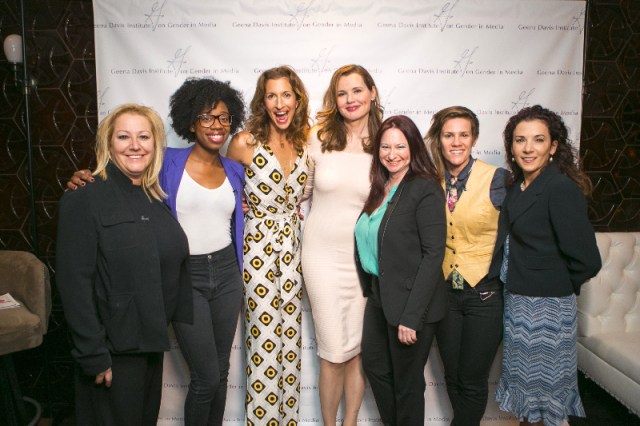
Nikki Levy, Geena Davis, Alysia Reiner et al. Gal Pal-ing around at a Ladies in Comedy Event in Los Angeles.
New York vs. LA: which has the better queer women’s scene?
This is a great question. I’m from NYC originally – Queens born and raised, and then moved to Park Slope, Brooklyn after college in 1999 (don’t do the math). When I lived in NYC, the girl queer scene was so… gay. I would go to Meow Mix and Henrietta Hudson ready to make some memories, and the women wouldn’t give me the time of day. Though I tried my best by wearing my Doc Martens and getting a really short, mistake of a buzz cut, I am very girly and no one thought I was a lesbian. I have big boobs, I don’t believe in baggy jeans for date night. Sue me. I also carry a purse, and I don’t own a wallet chain. Being a femme back then, no one thought I was gay. I sported a Pride necklace (the black cord with the rainbow rings) so people would have some idea. They just thought I liked rainbows.
The queer women’s scene in NYC at the time (I moved out to LA in 2002) was butch. And I never, ever fit in.
Now, cut to LA. I don’t know if it was because of the L Word, but LA was a femme for femme town. I’d walk into bars and be shocked to find out a woman is gay. She’d have on tight pants, a cute tank top, high heels. That’s the style here. And I fit right in. I joke that even the Dykes on Bikes in LA get their eyebrows done. There are no lesbian bars in LA, which is fine by me since large groups of lesbians have and always will intimidate me, but it doesn’t really matter because they’re coming out of the woodwork – literally. New York might have also femmed out since I left over 10 years ago), but LA is definitely the place for girly girls who like girls.
![DTMMmarch2015flyer[1]](https://develop.autostraddle.com/wp-content/uploads/2015/03/DTMMmarch2015flyer1.jpg?resize=435%2C640)
You can buy tickets for the March 26th performance featuring Jen Kober (The Middle), Angela V. Shelton (Hulu’s Quickdraw), Hannah Friedman (About a Boy), Alysia Reiner (Orange is the New Black) and Nikki Levy HERE
3 Alternative Natural Hair Looks For Scissor-Shy Curly Queers
I love my long natural hair. It is part of my heritage, my identity, and even my career as a performer. Some days, I wish I had an alternative look that might express my queerdo feels, but there’s no way I’m going to cut it all off (again). Natural hair doesn’t really lend itself to versatility, not easily at least. I rock what natural hair connoisseurs call a “wash’n’go” which sounds super simple and easy breezy but actually entails about 30 minutes of conditioning, detangling, and finger curling to smooth out the wily bits. Not to mention the approximately 20 minutes of blow-drying, which only does half the job. I spend the rest of the day with a slowly expanding afro. It is dry by maybe 4 pm. I’m really not kidding. It ain’t easy being natural, but it feels good. It feels healthy and like a part of who I am. I follow a few natural hair bloggers that make more complex natural hairdos look so easy, but I’m skeptical about the ability of the layperson who wants to achieve these looks. Given that doing my hair can be such a chore anyways, I decided to give a few of these styles a shot, and rate them based on ease, time, and queerdo suitability (1 being the easiest, quickest and milquetoast-iest, 5 being the hardest, most time consuming and gayest, respectively).
Janelle Pompadour
https://www.youtube.com/watch?v=s0pP3VHJLgA
I actually did this one for Halloween one year, and I can definitively say that it is easier the second time around. Make sure you do it with dry hair; it’s even easier because even if your curls aren’t at their perkiest, you can disguise them within the pouf, so it’s a good “day 3” hairstyle (hair that hasn’t been washed for three days). But it ain’t for the faint of heart. I’m going to need a few lessons in sass before I have the self-confidence to rock this one outside of the house. Ease: 2, Time: 1, Gayness: 5.
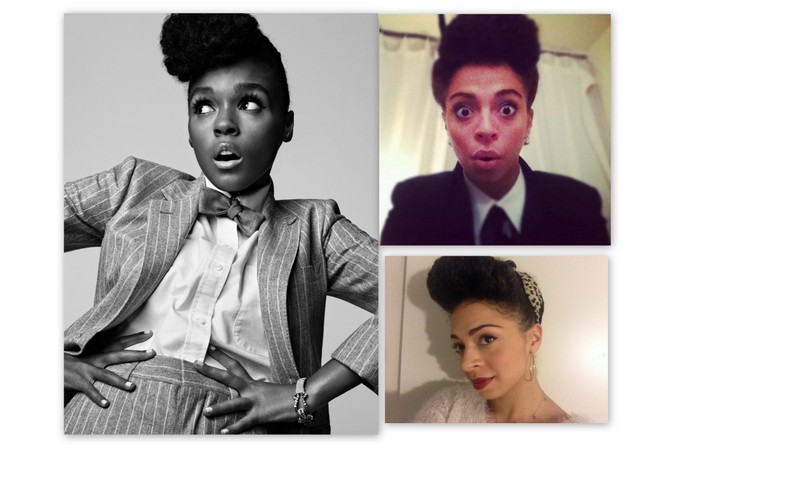
Uncanny, n’est pas?
Janelle via Mark Abraham Photography
Fro-Hawk
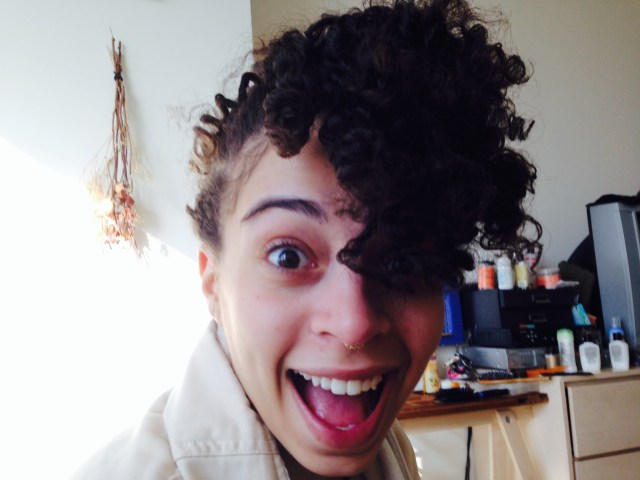
You get the idea.
This one is normally super easy if you start out with freshly washed hair, but I wanted my hawk to be more floppy, if you know what I mean. So I spent 24 hours with my hair in bantu knots (little knobby twists all over my head), disguised under a sweet head wrap. Those were fun to unravel, and then I just pinned up both sides into the center. Make sure to pin the sides as close together as possible, to achieve maximum height in the hair, otherwise it will be too wide and your head will look boxy. Ease: 5, Time: 5, Gayness: 5.
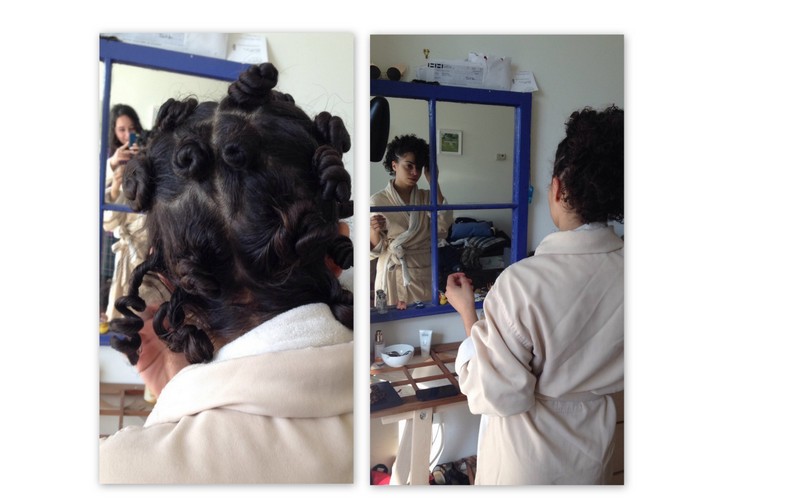
worth it just to unravel those little hair doodles.
Top Knot Bun With a Twist
It’s supposed to be easy enough, but I just ended up with what looked like a fresh pile of poop on top of my head. This might be a better style for people with longer hair and tighter curls so it’s easier to achieve the volume. Anyways I’m not even gonna post a picture ’cause I looked that bad y’all. Ease: 1, Time: 1, Gayness: 1.
Next time I’m gonna lock myself in my bathroom for an entire day and do temporary yarn dreads. Stay tuned.
Cathy & Marcy Celebrate Diverse Families with ‘Dancin’ in the Kitchen’
Grammy Award winning children’s musicians Cathy Fink and Marcy Marxer release their 44th album today, titled Dancin’ In The Kitchen: Songs For All Families. The recently married couple, who refer to their relationship as the “30-year engagement,” hope their album follows in the footsteps of Marlo Thomas, famous for creating the universally famous 1972 album celebrating diversity, Free To Be… You and Me. Surely you’ve heard it, maybe even suffered through assembly-time renditions in grade school. My middle school even printed Free To Be themed day planners. Thing is, though revolutionary for its time, Free To Be is a little dated. Fink and Marxer hope they can bring the spirit to contemporary issues.
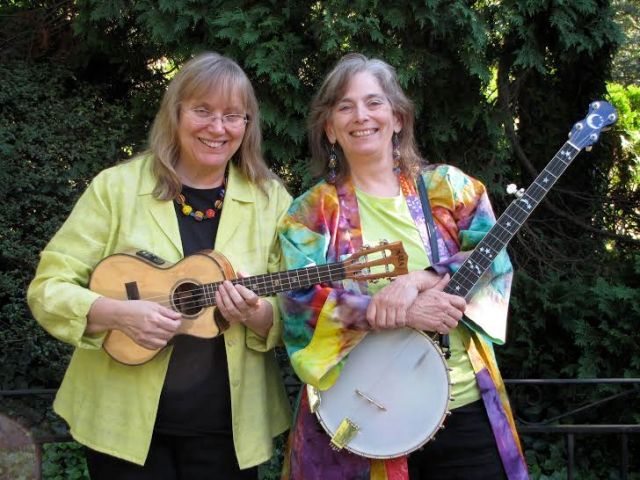
image courtesy of Cathy & Marcy
Fink and Marxer want to expand our definition of diversity. They have songs about adoption (“Happy Adoption Day“) and LGBT families (Dancin’ In The Kitchen With Mama and Mommy/Dancin’ In The Kitchen With Daddy and Papa). Primarily, the duo are concerned with complicating the notion of the nuclear family, and instilling children with the notion that every family looks different. “Marlo Thomas defined a family as a feeling of belonging,” Fink tells me:
I totally love that because that includes every family. It includes every family with an adopted kid, with a foster kid, it includes blended families, it includes multiracial families, it includes single parent families… Now, thanks to the work of so many great organizations, we live in a world where when you say the word ‘family,’ you aren’t thinking of the Cleaver family anymore… you’re not thinking of a nuclear family with a white mom and white dad and 2.3 children… every family is unique.
In the song “Soccer Shoes,” a child can’t find their soccer shoes because he lives with separated or divorced parents. “Twins” is a song about identical twins, written and performed by actual identical twins. The album boasts multiple songs with titles like “I Belong to A Family” and “Family Song,” all celebrating the different ways to define family.
Fink and Marxer use this album to open up discussions about themes that many parents might be hesitant to tackle. The album contains a story written and told by storyteller Andy Offutt Irwin, “Who’s In Charge of Naming the Colors?” during which we are prompted to discuss the oversimplified ways we identify skin color. A little boy sees some paint swatches at the hardware store, and uses them to name the colors of his multiracial family. Creating space for difficult conversations between parents and children has been both a goal and a side effect of their music making through the years. In 1992, the duo invited a children’s chorus to perform on their song “Everything Possible,” written by Fred Durst. However, upon reading some of the lyrics, many parents decided to pull their children out of the project. The offending lyrics?
There are girls who grow up strong and bold/There are boys quiet and kind/ Some place on ahead, some follow behind/ Some go on their own way and time/ Some women love women/ Some men love men/ Some raise children, some never do/ You can dream all the day never reaching the end of everything possible for you.
In the end, no matter the parent’s decision, each parent had to sit down with their child and explain exactly why they were not being allowed to participate in the chorus with their friends. I asked Fink if any of the parents ended up changing their minds about participating after a conversation with their child:
There was a family who came into the studio, they had a son in the sixth grade. The father was in the military, and apparently the mother and father had some pretty ‘hearty discussions’. He was against it, she was for it and in the end they left it up to the child. And the child said ‘I definitely want to sing that song.’ The interesting discussion between the mom and dad was that they had a son in college. And the mother finally looked at the dad and said ‘Are you trying to tell me that if our son comes home from college and says he’s gay, you’re not gonna love him?’
“Everything Possible” is also included on the tracklist for Dancin’ In The Kitchen.
The newlyweds will certainly be continuing to make music that embraces diversity, and you can keep up with their albums and children’s concerts at their website, cathymarcy.com. Buy Dancin’ in the Kitchen: Songs for All Families on Amazon.
“Post Traumatic Super Delightful” Uses Laughter To Talk About Campus Sexual Assault
This past Saturday I had the rare and special opportunity to see a play called Post Traumatic Super Delightful [PTSD]. Rare, because there are only two performances left to be seen in NYC, but it was special for a number of reasons. PTSD is a one-woman show that uses humor to traverse the complex and frightening terrain of sexual violence on college campuses. Using a silent clown narrator to break the silence around personal and community trauma, playwright/performer Antonia Lassar tells the story of a campus sexual assault through the voices of a professor, Title IX coordinator, and a perpetrator. Though the performance itself tells a singular narrative, Lassar explains that the characters are actually an amalgam of stories she collected through extensive interviews with victims, perpetrators and faculty who have dealt with campus sexual assault.

Antonia Lassar, playwright/performer and Angela Dumlao, director. images courtesy of PTSD
Lassar was introduced to clowning in Boston University’s acting conservatory program where she received her BFA in Theatre Arts, and continued practicing with the Barrow Group in NYC. But, she says, “I studied (bunny quotes) in my bedroom.” When asked if the production has received any negative feedback for using humor as a vehicle to discuss such a taboo subject, Lassar says they haven’t, not yet, “but we’re prepared for a reaction like that, which is why we make sure to include resources in the program and we make sure to market ourselves very clearly, because we don’t want to trick anybody into coming to a play about sexual assault who doesn’t feel ready to come to that play.” And in fact, they take special care to ensure audience members that they are free to leave the performance at any time without judgment. When they take the show on tour to rape crisis centers and college campuses, Lassar says they hope to have a Title IX coordinator or crisis counselor present at every performance as a liaison.
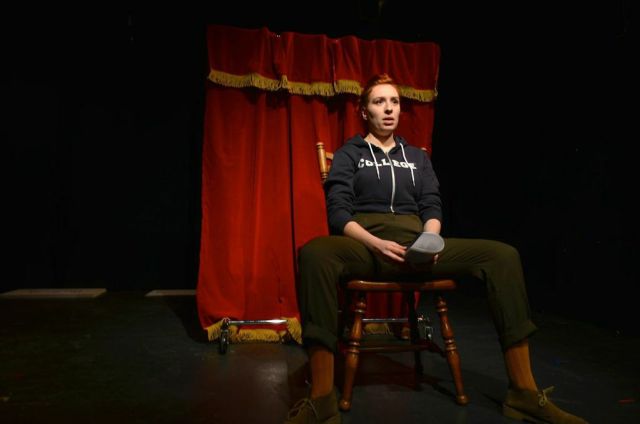
Antonia Lassar as “Bryan” the rapist. image courtesy of PTSD
Watching Lassar’s riveting performance — jumping effortlessly from Russian diva and Title IX coordinator, Lena, to alleged rapist and “southern gentleman,” Bryan, to the nervous and defensive professor defending him — the victim, Julia, is notably absent. In this world, Julia has refused to give an interview, probably for fear of her world falling apart even more than it already has. Given Lassar’s truthful and empathetic performance of Bryan the alleged rapist, one might begin to wonder just who this performance is trying to target, survivors or the community at large? “Both,” insists Lassar. “I think that both survivors and communities get different things out of it. I think that to target an audience of survivors is to emphasize the cathartic healing moments.”
These are represented in the silent clown, who is quite clearly an abstracted interpretation of Lassar herself. “And that came out of a ton of interviews with survivors, [where we] talked a lot about the pressures of fitting the survivor identity. And so, the clown is responding to that pressure… The interview moments speak more to community, because I also don’t think that community trauma has been addressed at all in the conversation around sexual violence.” Many people think this is as it should be. Why should we care how a perpetrator or community is feeling, when the victim is the person who has to live the rest of their life with this trauma? Lassar is concerned about the reproduction of sexual violence in a system that values loose punishment over healing — that includes healing for perpetrators. Lassar recalls the Hollow Water Indian Reservation’s solution to community trauma: a form of restorative justice that requires the perpetrator to sit down with the victim’s family, their own family, and the larger community to hear testimony on how their actions respectively hurt each group. Given that many of the people advocating for rape victims are the same folks who advocate for prison reform or abolition, it seems counterintuitive to suggest that we send rapists into prison where their behavior will likely reproduce itself in other harmful ways. Lassar thinks that because college campuses already deal with incidents of sexual assault outside the judicial system, it is the perfect testing ground for restorative justice techniques.
Angela Dumlao, PTSD’s director, has watched this play blossom over the course of the year:
This piece has evolved a long way to what it has become now… So, Lena the Russian character… before she became Lena the character she was a standup bit that Antonia used to do… I saw her do it before I was even on the team. So, that joke Lena makes in the beginning, ‘nobody wants to talk about sexual assault, god forbid we talk about the violence I went through, no let’s make sure you’re okay first.’ I watched Antonia slay that at an open mic. So even though we’re telling the story of Julia, I think there is a meta commentary going on about your [Antonia’s] survivorship.
Dumlao makes it clear that although the narrative arc of the play focuses on the case of “Bryan” and “Julia,” Lassar’s experience is the lifeblood of the entire piece.
Lassar and Dumlao are very vocal about the privileges that enable Lassar to put up this play: she is cis, white and able bodied: “the perfect victim,” and she has never named her rapist, which allows her to talk about her rape without being accused of lying. The characters in her play don’t necessarily have all of these privileges. Julia, the victim, is under enormous pressure to file a Title IX complaint against her rapist, which will inevitably result in unwanted publicity and further trauma, expressed succinctly by Lena in a moment of exasperation and anger: “What is point of justice, if victim is still hurting?” The hope is that through vocalizing our experiences, laughing about them even, we can begin to heal. Lassar recalls trying to talk about her own rape:
I like to approach my own trauma through laughter… What was interesting was that the natural impulse to want to laugh about it, and laugh with other people about it, was really hard to do. It was almost impossible to find somebody to laugh with! Because they were often so traumatized by hearing that I was a survivor that they totally shut down from laughing… Like faking tears when I talked to people, when I wasn’t sad! I just knew they would be able to hear my story better if I looked really sad.
She does want to make it clear, however, that her healing process has involved clowning and laughter, but “that’s not to say that everyone’s does. I don’t wanna make it sound like laughter needs to be in everybody’s healing process.”

Antonia Lassar as “Lena,” the Title IX Coordinator. image courtesy of PTSD
Laughter itself may be a privilege Lassar can afford due to her status as white and able bodied, a concession the performer/director duo are adamant about making. “The movement #TheresNoPerfectVictim started trending on twitter recently,” Dumlao tells me. “It’s just the idea that there is no one narrative for the survivor and usually the narratives we hear are of white, cis, straight, able-bodied, class-privileged women. And there’s this amazing article on Al Jazeera about disability and survivorship that we’re obsessed with. It’s the best article we’ve ever read about sexual assault.” The two of them are gushing over Azmat Khan‘s recently published article, The Hidden Victims of Campus Sexual Assault: Students With Disabilities. The piece chronicles a six-month investigation into sexual assault on Gallaudet University campus, a university specifically designed for students with disabilities. According to Khan, the journalistic investigation “uncovers troubling allegations from students who said their disabilities made them targets for sexual assault; that their experiences reporting that abuse were complicated by factors like disability, race and sexual identity; and that in some cases, sexual assault was even the cause of a disability, such as depression.”
Most disturbingly, but unfortunately least surprisingly, we learn that one year “Gallaudet University received 18 reports of what are known as ‘forcible sex offenses,’ according to crime statistics required by the federal Clery Act… And Gallaudet’s forcible sex offenses rate — more than 11 per 1,000 students, according to a ‘Washington Post’ analysis — was the highest per capita of any federally funded university with more than 1,000 students in 2012.” The piece clearly lays out the ways in which students with disabilities, along with other intersecting factors are at the highest risk for sexual assault with the fewest options for recourse.
Lassar and Dumlao hope that their performance will not be seen as an attempt to singularize the survivor experience, but open a dialogue that includes the experiences of sexual assault survivors from every walk of life. “We had been addressing this idea of ‘What is perfect survivorship?’ and now it’s become part of the national conversation,” Dumlao says. “And it’s been so exciting to directly address it… Hopefully because this dialogue is happening and we feel like we’re on the cusp of this conversation, people will understand how complex it is and how the survivor has no obligation to be what anyone wants them to be.” In a few weeks, Lassar will be traveling to Rice University in Houston, Texas to develop the post-show discussions and workshops that will become a part of every performance.
To fund their US and Canadian tour, PTSD will soon be launching a crowdfunding campaign. “We want to make the play as free as possible for [rape] crisis centers,” says Lassar. They officially start their tour at Rice University in May, pit stop at the Minnesota Fringe Festival at in the first week of August, then make their way up to Canada for the Edmonton Fringe Festival. They are still in the process of booking colleges and crisis centers, but you can always check their website PTSDtheplay.com for updates, and information on contacting the team about booking the show for your very own college or crisis center. Follow the play on Twitter for more instant gratification. There are two performances left in NYC, as part of the FRIGID Festival. Performances are Wednesday March 4th at 5:30pm, and Friday March 6th at 8:30pm at the Kraine Theater. Get your tickets HERE.
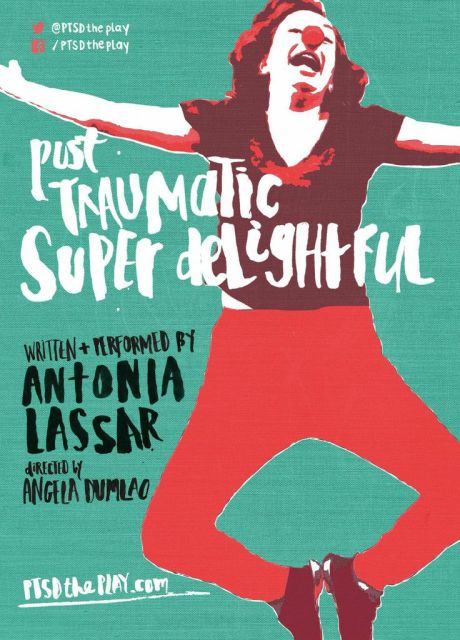
Poster courtesy of PTSD
5 Shoes For Braving This Disgusting Winter Slush Situation
It’s that very special time of year. If you live anywhere remotely cold and urban, the streets are a treacherous mess of exhaust stained, dirty, icy, sidewalk garbage snow. Crosswalks are impassable and the city is frozen tundra. Otherwise, as soon as the temperature begins to rise and you think you’re in the clear, the ice skating rinks that before encircled every street corner, have become moats. Our feet take the most abuse in this weather, testing the slushy waters before we make the great leap. It can be near impossible to look put together and stay warm in these trying times. But it can be done! My go-to she is a pair of Cole Haan charcoal grey waterproof leather oxfords, but they don’t make those no more, so I’ve scoured the web for an icy garbage snow shoe for everybody’s tastes.
Waterproof Oxfords to Keep You Dapper and Dry
These Ahnu waterproof Oxfords are perfect for keeping your feet dry with waterproof leather, neoprene and some other fancy scientific materials. They also come in a variety of colors.
Doc Martens for The Punx
These vulcanized rubber combat-style Docs have a high ankle to keep your legs dry in case you slip into a lake puddle, and come in both black and floral patterns.
Ballet slippers for inside your ‘Bean Boots
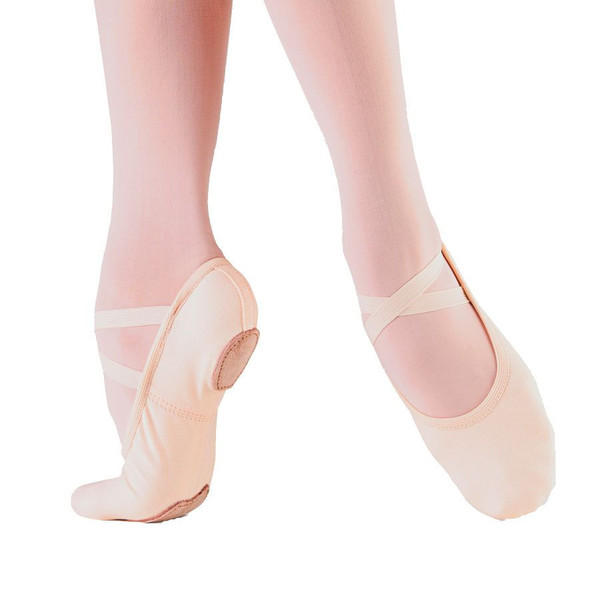
So Danca Adult Canvas Split-Sole Ballet slipper. $17.99 on Amazon
I had this great idea for when I’m going to class and I need to keep my feet dry without carrying two pairs of shoes all day. I bought a pair of split-sole ballet slippers to wear inside of my clompy winter boots. Now I just ditch the boots at the door and I don’t have to worry about dragging slush through the halls.
Hot Heels to Melt the Ice
If the idea of wearing two pairs of shoes at once is a little weird for you, these winter heels from Sorel are great way to transition from the Arctic outdoors to an indoor event. Warm, totally waterproof, and great traction make these boots perfect who is determined not to sacrifice a high fashion height to a little snow and ice.
Hiking Boots for the Urban Butch
Sometimes you just want a good winter hiking boot that doesn’t make you look like you’re about to scale Everest.
These “Winter Fancy” boots from Sorel are a great shape and color and classy silhouette. A no fuss boot for a no nonsense pedestrian. The Danner Mountain Light Cascade boots come in a beautiful tan leather that is water-resistant. Apparently they were worn by Reese Witherspoon in the movie Wild… so there’s that.
Happy puddle jumping my pretties!
Sleater-Kinney and Broad City Compare “Vag Badges,” Tell You What to Read, Watch and Listen To
Last Friday, the stars aligned over Manhattan to make my deepest darkest feminist dreams come true. I got the chance to see Abbi Jacobson and Ilana Glazer of the hit comedy series Broad City interview lady punk band Sleater-Kinney at the Ace Hotel for NPR. Autostraddle’s very own Portlandian Alley Hector accidentally won tickets to the event by answering some Sleater-Kinney trivia on Twitter, and I nabbed them because I desperately wanted to redeem myself in front of my idols.
You see, last July 4th my friends were over at my apartment in Brooklyn. Amidst our revelry, my friend burst through the door to show us a ridiculous (read: drunken) picture on her phone of herself and Abbi Jacobson — tongues out, eyes akimbo, in MY elevator. MY ELEVATOR. My other friend Quinn and I have this theory that Abbi and Ilana follow us around to develop the material for Broad City. I mean, we even look and act JUST LIKE THEM, but like, more intelligent… I’m hoping. For the next ten minutes, Quinn and I calmly debated (read: hyperventilated) the ethics of approaching our doppelgangers lest we all self-destruct.
Verdict: YOLO.
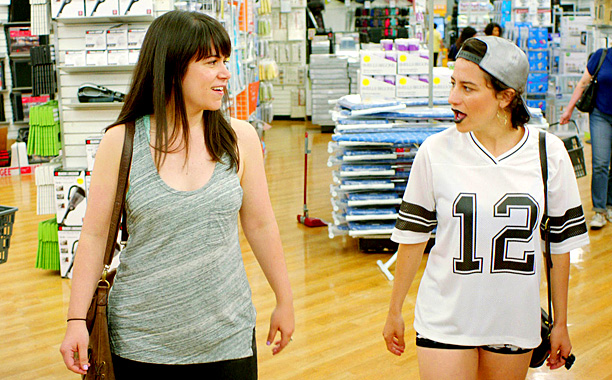
“Abbi I can’t find Quinn or Hannah anywhere! They must be in the Kitchenware section.”
image via Flavorwire
Through some super sleuthing we deduced that we could find them smokin’ on the fourth floor community deck. Quinn tried to play it cool by asking them for a lighter, and I tried to crack a smile as every motor function in my body shut down until all I could do was giggle, snort and smoke. Quinn did all of the talking, and I did all of the keeping my trap shut in case some puke came out accidentally. We snapped a few pics for posterity and I steamrolled my way back inside where we both took a moment to literally convulse on the floor cackling in simultaneous shame and victory.
Fast forward to Friday night, Quinn and I had a second chance to see Abbi and Ilana again while they interviewed Sleater-Kinney. The Broad City duo made a very successful effort at gearing almost the entire conversation toward defining feminism and what it means to be successful women. Sleater-Kinney and the ladies of Broad City showered one another in accolades, with Glazer assuring Sleater-Kinney that they couldn’t have existed without them. One of the first questions asked was: “Does rocking hard equal gender equality to you?” which was received with a resounding “Yes, absolutely,” from Corin Tucker, Carrie Brownstein and Janet Weiss.
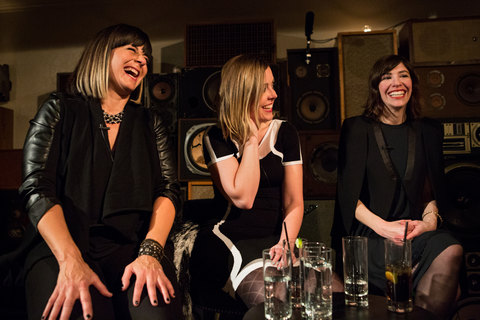
image via Brooklyn Vegan
Asked about the evolution of the “Tribe of Sleater-Kinney,” Corin described 90’s era Sleater-Kinney as necessarily confrontational, and “Phase 2” Sleater-Kinney as evolving to be more inclusive, and chipping away at visibility for women in entertainment. Carrie Brownstein, rocking a very sexy cape/blazer deal that I have dubbed a “caper,” descended from the feminist heavens to eloquently define Sleater-Kinney as “the soundtrack to these tumultuous times.”
Importantly, I think they made it clear to Abbi and Ilana that feminism is not just an ode to the women who came before us, but an ever-evolving movement that dedicates itself to complexity — we should embrace the challenge of making feminism complicated, intersectional, and revolutionary.
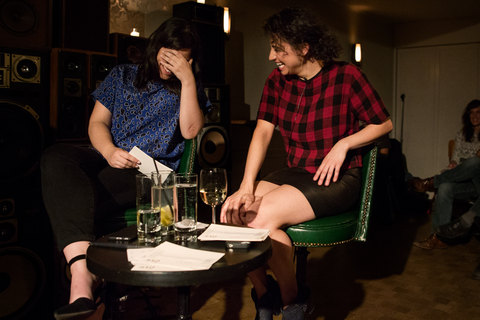
image via Brooklyn Vegan
Carrie discussed the difficulty of wearing the “vag badge,” and being pit against other female artists, decrying that only women, people of color and rappers get asked to crap on other musicians who revolve in the same orbit. “We want to be able to create our own adjectives,” she said as Janet jumped in to lament the fact that women’s music has been “ghettoized,” and is only talked about in comparison to other female musicians, even when the two bands have an entirely different sound.

image via Brooklyn Vegan
And since I know you are very good girls and bois and already plan on purchasing their latest album, I thought I’d give you the inside scoop on what they’ve been jamming to and reading about and looking at. I will bore you with only these details:
What You Ought to Be Reading:
Carrie Brownstein
This belipsticked, golden throated goddess wants you to read Miranda July’s new book The First Bad Man. I’m sold. Seriously Carrie Brownstein could tell me to buy her dinner and I’d be like “No problem Carrie Brownstein. I’m a little tight for cash right now but you get that steak tartare.”

via Flavorwire
She also thinks you should read Book of Strange New Things by Michel Faber, which is a dystopian space travel adventure novel. Incidentally, this is my favorite sub-genre of novel.

via Creative Review
Carrie also thinks you should read Angelica Huston’s memoir, but did not indicate exactly which one, so for good measure, just buy them both. A Story Lately Told: Coming of Age in Ireland, London, and New York was released in November 2013. Watch Me: A Memoir was released in November 2014.
Last but not least, Carrie lists James Baldwin as one of her all time greatest influences, specifically The Fire Next Time and The Devil Finds Work, which are both important texts in the black literary canon, but also timeless and relevant in “these tumultuous times.”

Via Amazon and No Film School
Abbi Jacobson
While Abbi had some troubles getting her questions in during the interview, she was at the ready with book suggestions for more introverted extroverts like herself. The Goldfinch by Donna Tartt was at the top of her list, as was Bad Feminist by our very favorite Roxane Gay.
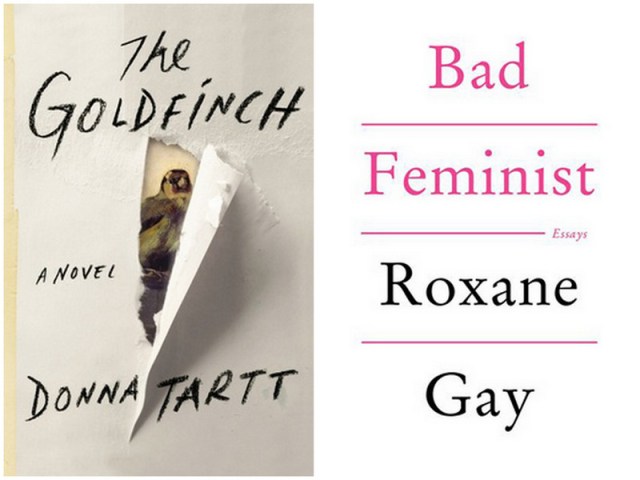
Via Wikipedia and Roxanne Gay
Ilana Glazer
Ilana does not read, but thinks you should listen to Amy Poehler‘s Yes Please on audiobook, which is guaranteed to make you look like a crazy person while you laugh your guts out listening to a book during your morning subway commute.

via CBS News
Watch It On Your TV Screen (okay, your laptop screen):

Lisa Kudrow in the hit HBO series The Comeback image via BBook
Carrie wants you to watch the comeback of The Comeback with Lisa Kudrow on HBO. Abbi thinks you should watch Transparent on Amazon Original Series, and not just because Carrie is on it, she swears.
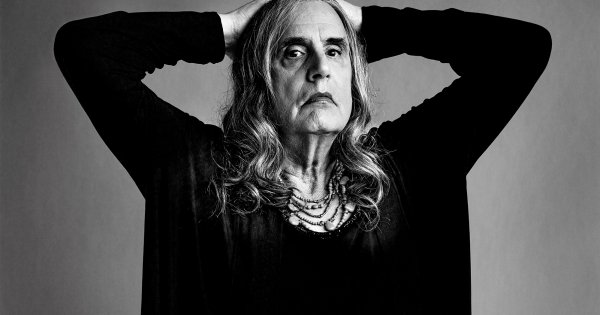
Jeffrey Tambor plays Transgender parent Maura on Transparent image via Vulture
For Your Earholes:
The ladies of Sleater-Kinney listed their greatest influences and — spoiler alert — they’re all kick-ass lady music makers:
Corin Tucker
Thinks you should get hip to Kim Gordon of Sonic Youth. You can start by downloading their first studio album Confusion is Sex on Amazon. Then you can read Gordon’s memoir Girl in a Band when it comes out in February.
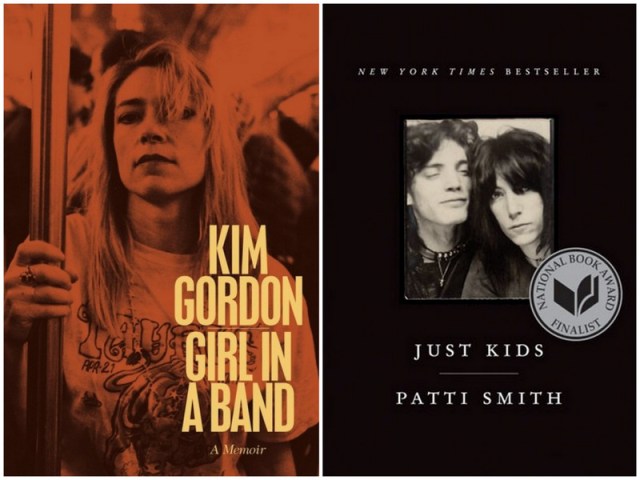
Via Sterogum and Women’s Voices For Change
Nobody doesn’t love Patti Smith, and if you don’t yet, you will after you listen to Horses, while reading Just Kids.
Janet Weiss
Janet is heavily influenced by Jody Bleyle of the bands Hazel and Team Dresch. You can find Hazel‘s “Toreador of Love” on Amazon along with Team Dresch’s “Personal Best”.
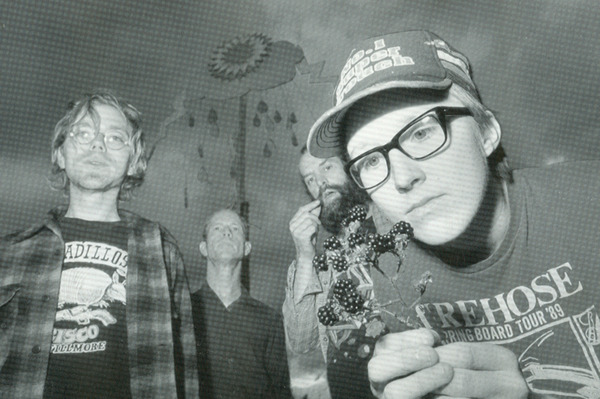
Hazel
image via Subpop
You can watch the interview over on NPR. Sleater-Kinney released their latest album “No Cities To Love” on Tuesday. Buy it on iTunes or on Amazon (Vinyl). You can watch new episodes of Broad City on Wednesdays at 10:30/9:30 c on Comedy Central.
Broken Windows is On Hiatus: Community Interventions We Can Enact Now for Real Justice
feature image via Shutterstock
About a week ago, the NYPD had millions of liberal New Yorkers scratching their heads when they announced a “virtual work stoppage” in apparent protest of Mayor Bill DeBlasio’s alleged lack of support for the Boys in Blue. This came after not only weeks of protests against police terror in New York and across America, but also the senseless murders of two police officers in Bed-Stuy, Brooklyn. Though DeBlasio condemned the murders outright, the police and their union are arguing that his show of support for protesters incited the murders, despite having been committed by a man who had a history of mental illness and shot his own girlfriend in the stomach that very same morning. The police have used this opportunity to literally turn their backs on the mayor as he approached the funerals for the fallen officers. It should be noted that the police union is also currently arbitrating with the city for higher pay.
And so, the police have decided that in addition to the symbolic act of turning their backs on the mayor, they will also stop arresting people for low level crimes (e.g. “quality of life” crimes like open container summonses, public urination, and even parking tickets), resulting in a staggering 66% drop in arrests—and likely an equivalent drop in ticket revenue for the city. The union urged officers not to make arrests unless “absolutely necessary,” leaving most of us wondering what in the hell they were doing before (okay, okay. We knew. It’s just kind of nice to hear them finally admit it). In a bizarre, twilight zone situation, the police have actually practiced civil disobedience and temporarily halted the racist, classist, “broken windows” policing practices that have been the ire of civilian protesters since their introduction. Yeah you heard that right, and it is having benefits for everybody, especially low-income workers and the homeless. Furthermore, the sense of relative serenity in low-income neighborhoods is a welcome change of pace from the constant and looming police presence that has become normalized in these areas.
The incidental benefits of this work stoppage are a bit of a relief, but they are also an opportunity to implement community-based alternatives to policing. Because while we are celebrating the ability to double-park our cars without fear of being ticketed or towed, we are also turning our backs on the millions of incarcerated people who are being brutalized behind closed doors. We are turning our backs on people of color, women and queers who will undoubtedly still bear the brunt of arrests that are being made. Instead, we can forge ahead and create the world we want to live in.
In a the first of a series of video discussions with activists Dean Spade and Reina Gossett, Gossett discusses ways to “prefigure the world you want to live in” through a prison abolitionist lens:
Abolition to me means a number of things. It means preventing harm, intervening on harm, having processes for repairing harm and violence, and also having an aim towards transforming communities, and transforming relationships so that the harm that people have experienced, they’re not re-enacting onto another person.
Abolition means that no one is disposable, no one is expendable. We are not exiling people or punishing people in order to solve our problems. There is a logic in the prison system of policing that kicking someone out of the community and punishing someone is a way to solve people’s problems, but we’re seeing time and time again that that doesn’t work.
Yes, broken windows policing is one of the worst, most racist things to happen to the police and prison system. But even without broken windows, we are left with a prison system that unfairly mishandles people’s lives, especially Black and brown lives. With an eye toward dismantling the current system, there are viable alternatives to involving the police. Many of these focus on low-level offenses, which is a great place to start when looking towards dismantling the entire violent prison system.
In late December, Mike Ludwig of truth-out.org suggested we enter the New Year by resolving not to call the police. For the very same reason that many POCs in poor neighborhoods already choose not to call the cops, Ludwig urged readers to consider how we define safety: “Do we feel unsafe in working-class neighborhoods, or around people with certain styles of dress or colors of skin? What prejudices ground this fear?” He implored readers to think about exactly upon whom we call the cops, and whether they will be treated fairly by the police in a country where police kill one black person every 28 hours. Ludwig makes an important caveat: “Violence is the most serious challenge. If you feel that your safety is threatened, and the best option to avoid being harmed is calling the police, you should do it. Resolving not to call the police is not a rule, just a way to think outside the box. Rules are for the cops, not for us.” Basically, if there is a way to resolve the issue at hand without putting oneself in danger, why not try that option first? As Ludwig points out, many communities are already testing transformative and restorative justice projects that we can use as models during this little policing hiatus.
In Buffalo, NY, local churches, mosques, synagogues and community centers are testing out “peace hubs” in an effort to circumvent police interactions with young offenders. Community conflicts are brought to these peace hubs, and resolved on an interpersonal level. Rod Watson of The Buffalo News thinks it could level the playing field for underprivileged and marginalized youth:
In some ways, it’s a throwback to the days when, if a kid did something wrong, he got chastised twice: first by the neighbor who caught him, then again when he got home. The community wasn’t afraid of its young people and cared enough about them – all of them, not just relatives – to intervene early enough to keep them on track.
If successful, the peace hubs could again give city kids the type of guidance and support suburban kids routinely get to keep them out of the prison pipeline when they do stupid things.
Other organizations like Young New Yorkers aim to both keep young POCs out of prison and engage them on an artistic level that brings their skills back into the community:
Young New Yorkers is a restorative justice, arts program for 16- and 17-year-olds who have open criminal cases. The criminal court gives eligible defendants the option to participate in Young New Yorkers rather than do jail time, community service and have a lifelong criminal record…
A series of six intensive, hands-on workshops prepares the participants to design a public art installation that expresses a positive social message of their choice. Local artists join each workshop and assist the participants in weekly art projects. The weekly artworks and the final installation design are then presented to the public at the Young New Yorkers Finale. The Finale allows the participants to experience themselves as worthy, creative contributors to their communities, rather than as undeserving and irredeemable criminal actors.
Young New Yorkers intervenes after a young person has already interacted with the police, but it is important to have community intervention solutions at every level of the process. The running themes here are empowerment and responsibility to your community, and reducing the harm and violence of mass incarceration. When young people of color are shown that they can make a difference in their communities and in their own lives, prison doesn’t seem like such an inevitable outcome, and commitment to creating justice without police in our communities is a tangible action towards dismantling the prison industrial complex. In addition to fighting for reforms within the prison system, we can keep people out of prison in the first place. We can literally be the change we wish to see in the world.
Five Queers Of Color On What Connects Us To Our Complicated Or Mixed-Race Identities
There is a sense of community that comes with being a person of color, but for some of us, settling into that community isn’t always comfortable. Because we don’t get a membership card along with our birth certificate, finding our identity comes with the burden of having to “prove” yourself. Whether you’re bi-racial, adopted, or otherwise ethnically ambiguous, there will always be that person who wants to know, needs to know: “What are you?” And while most of us have a stock answer, secretly we’re thinking “I’ve got no clue, dude.” Many of us struggle to prove our authenticity to ourselves first, and find ourselves deeply attached to little reminders of our roots. And those reminders, large or small, become the thread that weaves the stories of our lives. These are a few of those stories.
Hannah Hodson
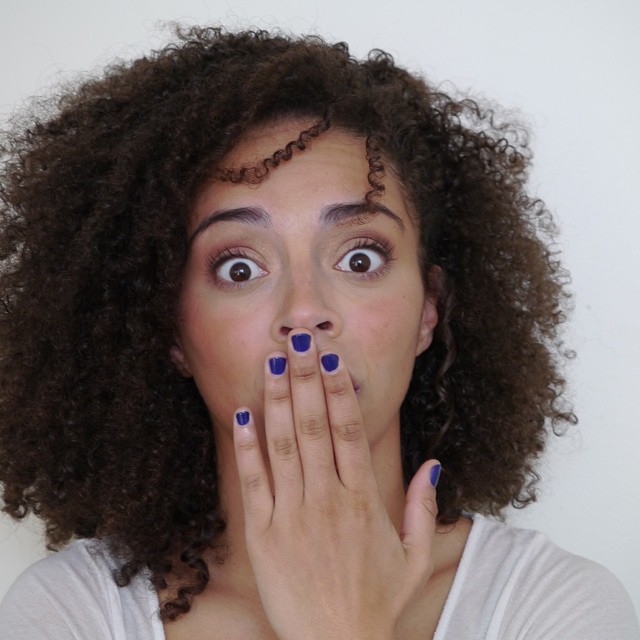
I have always gravitated towards “alternative lifestyle” looks. When I got my septum pierced I was worried people might confuse me for one of “those queers” (It seems my fashion choices have always preceded my self-discoveries). One thing I have always wanted is to dye my hair a whacky color or get it all chopped off into a funky ‘do. As I’ve embraced my bisexuality that urge has only grown stronger. But there’s a part of me that has feels a longer standing allegiance to being a biracial woman. In particular, I’ve always felt like I need something to prove to others and myself that I am authentically African-American. Somehow, even as I remind myself that authenticity is an unattainable social construct, I yearn for a cultural heritage that I might recognize in myself when I look in the mirror.
Once, when I had lice as a kid, my father took me into the backyard and buzzed all of my hair off. He was very satisfied with his handiwork. My father, a white guy, had always been my hairdresser. My Black mother had her hair relaxed since she was a child and in fact the texture of my hair was more similar to the white boy ‘fro my father had rocked in his teenage years (before he went bald, that is) than hers. My hair was his domain. This meant that when I got lice it was also his job to slather my head in margarine and a swim cap before bed, boil all of my hairbrushes and discard my scrunchies. After my third infestation, he thought he would just save himself some trouble and just get rid of my hair alltogether. I don’t remember having a problem with it.
Upon returning home my mother was devastated that he would “mutilate” me like that. My Jamaican pre-school teacher and nanny told him that he had cut all of my “power” off. While pretty much nobody asked me how I felt about it, these two women were concerned for two very different reasons. My mother had internalized her idea of what good hair looks like: mine. And while she was content to douse her hair in chemicals every month, she saw potential for me. Her hard work and education afforded my sister and I opportunities that she had to fight for. Our fair complexions and loose curls would further help us live privileged lives. Maybe she was jealous? I mean she was also angry because it’s ridiculous that my dad thought it would be okay to shave my head without consulting her, but I think she saw in me the image of perfection, and he took that away from her. My nanny, on the other hand, saw my hair as my “power”: my Blackness. I think that stuck with me. Not only has my “good hair” been a marker of the many privileges I enjoy as a half-white person, but a way to remind myself that I am genetically, authentically, Black as well. One does not dilute the other.
And so, I rock my natural hair long and wild. I spend exorbitant amounts of money on paraben and silicone free hair products so that I can grow it longer and wider. I hang onto my curls like they are the very things that define me. I think it’s difficult to find a sense of balance when you are constantly being told you’re “not really black” or “not really gay.” Even as I consciously tackle these issues I feel like my hair is my security blanket, my constant. And it is precious. And you may not touch it because it is a mystery to you and that is okay with me. I’d prefer to remain mysterious while I figure my own shit out.
Carmen Rios
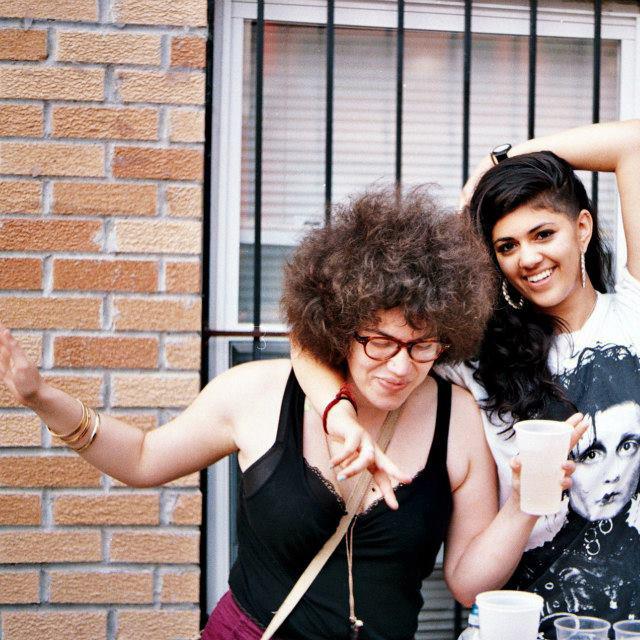
When I was a little girl, I notoriously insisted to my mother that one of her childhood photos was a photo of me. “C’mon, mom, seriously. When did you take this photo of me?” My mom is white, Italian, Bronx-bred and Jersey-raised. I am my mother’s duplicate, a tiny reminder of herself. I was raised by my mother and my mother alone, and in every way I am my mother’s daughter.
Except for the hair.
When I was younger, back before elementary school, I had long, soft, simple hair that fell in place and got put up in bows and buns and big hair clips all the time. I loved my hair. And then, when I got older, it changed. It tangled almost instantly, grew at the speed of light, and had more volume than any other head of hair in all of my majority-white, suburban classrooms. I was different. I didn’t know why. I fucking hated it.
I have my father’s hair. My hair stylist as a kid told me the texture was “hexagonal,” something she’d never seen before or really studied. By the time I graduated high school, I had attempted to straighten my hair dozens of times. None of the chemicals worked, except one, made up of various chemical compounds that were applied once a year in a six-hour non-stop marathon of hair care. My stylist used to close her shop down and have us show up on a Saturday morning, bagels in hand and magazines at the ready.
Someone told me once that my Puerto Rican roots didn’t matter because my father wasn’t in my life. “It’s not like you’re even really Puerto Rican.” It all came back in that instant like a flood. I remembered kids teasing me about my hair all throughout my childhood and late adolescence. I remembered crying in the mirror and in the bathroom and on my mother’s bed as we tried process after process to make me “normal,” “beautiful,” white. I remembered the day I cut my hair into an afro, and all the days after that where people verbally accosted me for it, interrogated me for it, judged me for it, made fun of me for it. (And I will most certainly never forget the people who pronounced it Car-Man Rye-Ohs, because that shit ain’t right.)
There’s this photo of my father that I saw once when I was in his brother’s home, and he’s graduating, and he’s young, and he has an afro. It was years before I would cut my own, but when I eventually did I would think about it and assure my mom I knew exactly what I was doing. “I have dad’s hair. I know what it’s gonna look like. I know it’s gonna work.” Sure enough, it rose at the roots and never fell down and stayed all the way up there for years.
My father’s hair watched me graduate college without my cap on, watched me buy the leather jacket and boots and go to my first lesbian bar, helped me kiss a girl for the first time. That hair taught me lessons and how to love myself and how to shine and be vibrant and be brave and be real. That hair taught me how to fight. That hair taught me to be weird and different and outrageous and authentic. And in a world where it can be easy for me to feel invisible and forget my own name, it still reminds me who I am.
Intern Cecelia
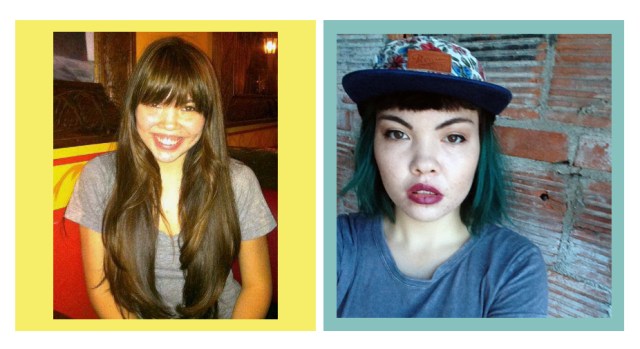
I remember the day I decided I was going to be really, super white. It was the summer of fifth grade and I filled journals with scribbled hate manga to spite all the Carly’s, Zoe’s and Taylor’s of elementary school. Then, I opened a new journal, this time filling it with hundreds of cut-and-paste pictures of beautiful girls in magazines. I didn’t know it then, but the privilege of being white passing means having the ability to choose how I’m viewed by others. Because regardless of my cultural background, racially I am pretty damn close to white on the spectrum from brown to white. Being authentically white was as close within my reach as some hair dye and a pair of tweezers, and because of that, I was obsessed with proving I could pass.
Unfortunately, when you’re eleven and sick of being bullied and having only internet friends, you don’t really see the “caution, permanently internalizing white heteronormative ideals” signs posted ten years ahead in the future. I didn’t realize that I was socialized to define success as inherently linked to whiteness, so I feverishly collected trophies (being adopted into rich white boyfriend’s family, becoming the bully) to nurse the hope that no one would notice I didn’t belong, because it always felt like I was almost there.
In reality, I’ve always been a Japanese and Jewish southern queer kid raised by a single mother from a lower-middle class background. These are the markers of my identity that, for years, never fit neatly into my plan. I’m unraveling the feeling that I should be ashamed of these things one at a time. A little over a year ago I started chiseling back the layers of my identity to find the queer underneath, eight months ago I actually started calling myself queer, and a few weeks ago I had one of those transcendent moments of self-actualization where my body clicked into the word queer without feeling hesitation or fear.
Truly accepting myself means letting go of the security that comes from trying to fit into convenient categories. I’m not sure what I am these days, but at least I’m not worried about what I’m supposed to be. Being a mixed race queer has taught me that there’s probably no way I could ever truly be what I’m supposed to be, anyway. After years of buying into an identity pitted against my own personal love and acceptance, it’s nice to finally live in the question of myself. Accepting ambiguity feels like being welcomed home.
Alley Hector
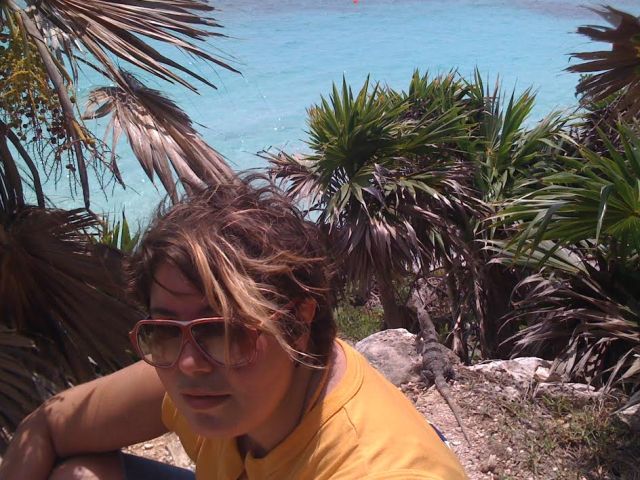
I often like to start my family story with names. See, my name is Alley Hector. I made an Iranian friend in Turkey once whose name was Ali and he said, “Hey our names are the same. But that’s a man’s name.” It wasn’t the first time I had been called Mr. Ali Hector in correspondence. My surname, my family name, too, is a “man’s name.” It also sounds vaguely Latino. Indeed, I am vaguely Latina. But not because of this name. This name, my family name, is completely made up.
The man who bore the last name “Hector” was semi-well-meaning dude, now a year dead, who married my single grandmother in 1964 when my mother was 14. He adopted her and my aunt, two girl-children with different fathers, born out of wedlock in 1950’s north Jersey. It was a pretty grand gesture so perhaps he deserved to attach his name to ours forevermore. Funny thing was, his father had actually completely made it up when he emigrated from Germany to sound more American. My mother’s biological father’s surname was Janin, though she had originally gone by Dennis, my grandmother’s maiden name, because that guy didn’t want to leave his surname behind. Which brings me to my father, who most likely didn’t want to leave his either, which is why I am not Alley González. But okay — this is supposed to be about being mixed race, not personal family drama. Unfortunately, for me, one cannot be teased out from the other.
Luis E González was from Caracas, Venezuela, schooling in NY/NJ in training for an engineering job with a prominent oil company. Though I’ve never seen him, my mother describes him as a short, thin man with olive skin and dark hair. Now Mom is a white mutt from the Tri-State area and I am too. My skin and hair are darker than hers but I still walk this country like the privileged white person I am. But there’s still that dark skinned guy, just sitting there uncomfortably in the background of my family tree, with no names lined up behind him.
In elementary school I’d often sign my homework Allison González-Hector and I was always trying to take Spanish lessons or do country reports on Venezuela. I even brought a mildly alcoholic drink to school during presentations one day, a coming-of-age drink you imbibe on your 15th birthday called Ponche crema. And I really did think then I’d have a Quinceañera some day. But by the time I actually was a teenager I wasn’t quite as ready to celebrate this culture I really only knew secondhand, this ethnicity of a man who had walked out and never looked back.
Now it feels disingenuine either way.
I was raised in whiteness and I walk through this world as white. I strive to be an ally to my QPOC siblings and seldom claim a space among them. But is disavowing my lineage just as harmful as pretending I have a knowledge of life as a QPOC that I do not? And here’s where family drama, cultural context, the larger institutions of racism, and immigration policies get all muddled. Now, where is that immigrant who moved from Caracas to get a degree in the states to help me when I need him? (I mean, I have all these questions, Dad, about who I am and where I come from, what languages I should speak and what my place is as an American.)
Actually, it turns he’s in Texas, and on LinkdIn. I found him there about 6 months ago based on his former employer. So I contacted him (you know, just to let him know I had a few questions about life and race and family).
But I’m still waiting to hear back.
KaeLyn Rich
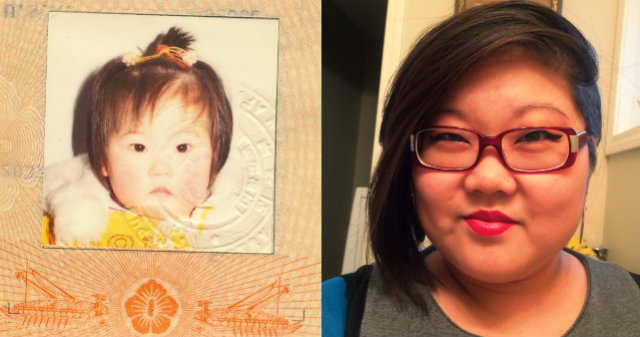
I was one of the smart kids in high school, an A-student, with a whole pod of straight-laced friends who didn’t drink or cut class. Like so many young closeted queer-mos, I have always been attracted to the extremes. Something about your feelings and desires and longings frantically trying to claw their way out through your arteries makes us want these things, amplifies the wanting: piercings, wild hair, getting too drunk on cheap beer and red wine, tattoos, skirt-hikes in dirty bar bathrooms, getting the boi or girl in the leather jacket, being the boi or girl in the leather jacket. Whether that was about being the only Korean in my school or about being in the closet or neither or both, the feeling was overwhelming. I can still feel the places in my body scorched by that wanting, that deep frenetic desire.
Somewhere around my senior year of high school, I started to quietly lash out. I kept up my grades, but started wearing funkier clothes and makeup, dyed purple streaks in my hair, went out with older bad boys from other schools, snuck into bars with a chalked ID, and fumbled my way into my sexuality. When I went to college, I picked a school where I’d be the only one from my high school class. The night I arrived on campus, I went to a frat party and made out with girls. By the end of the first weekend, I had pierced my tongue. And before thanksgiving break, I had my first tattoo.
I knew my first tattoo would be my Korean last name, the name I was assigned before I was adopted. My Korean name was probably not my first birth name, as my “origin story” is one of those adoptee story cliches and was probably meant to cover a less sweet story. (On my adoption paperwork, I am a “foundling,” meaning no one surrendered me or took me from my first home. I was “found.”) My name on my adoption paperwork is Lee Eun Jeong. I can’t pronounce it correctly because I don’t know Korean. I do know the the “l” in “Lee” is pronounced like a “y” sound in Korean.
I know this because the white guy who did my tattoo of my Korean name was stationed in Korea for four years. When I walked into his shop, he said my laugh sounded Korean. My laugh is different or, uh, distinctive, you might say, but I’d never thought of it as possibly being tied to my ethnicity. Until I finally embraced being Korean, which really only happened a few years ago, I always felt like an imposter, that I was white by nature of the passing privilege handed down by having white parents. That bits of my Korean-ness were showing anyway, despite my best attempts at hiding them, was both unsettling and fantastic. I had him do my name tattoo and two others after that.
My name is KaeLyn Rich, my legal name, the name my parents gave me when they adopted me, the only name I know and answer to, the name I can pronounce. My first name was Lee Eun Jeong, assigned by the orphanage, strange on my tongue. My last name is my Dad’s Italian family name, changed from Ricigliano at Ellis Island. My mother’s family names are Swedish and German. I am part of my family’s legacy, but the legacy behind my family names is not mine, not really. I will never resemble any great aunt or have kids who look like my father’s brother. My people didn’t live in these countries, eat these foods, wear these clothes. My family is my family, held tight by loving and legal bonds. My family names, however, do not correspond to the nameless baby girl “found;” to the girl with the generic Korean name adopted; or to me, now, the American woman with the pseudo-Gaelic first name. KaeLyn is the name I know, the best version of me, the familiar and the strong and the passing and the comfortable. The foreign name permanently inked on my spine in black and red, I will always be reaching back to.
Are We There Yet? An Interracial Family Visits a Southern Plantation
The evening I touched down in New Orleans, about to embark on a soul-searching family trip to various sugar plantations, the Darren Wilson decision was reached in Ferguson. I was sitting at a down home barbeque restaurant with my mixed-race sister, Black mother and her white boyfriend of nine years. I mean, we were the friggin’ picture of post-racial prosperity, and yet every one of us was slapped back to reality in one timely Google search. We are avid mealtime Googlers. If we had set the table ourselves it would look something like, from left to right: salad fork, dinner fork, dinner plate, water glass, wine glass, napkin, soup spoon, knife, iPhone. Conversation consists of getting into heated debates that more or less end in Googling the answer; either that, or eavesdropping on the neighboring table and picking up where they left off.
I’ve never been to a protest. Well, I went to one teensy Occupy protest in Amherst while I was at Hampshire, and I did one of those bogus walk-outs in high school so I could drink booze and smoke cigarettes and to feel like part of something cool. But really, as an active participant, no. I’m not proud of this, but I never felt compelled to participate in one — until that night. There was a fury brewing in me that I had never experienced before and I wanted to take to the streets and burn some shit down. Fortunately, I did not have the opportunity to commit arson that night because I was having “family time.” But I’d never felt this before; like somebody was shaking me by the shoulders and saying “you’ve got to do something!” Of course, we were set to embark on a road trip where not only would I have to swallow this rage, but I would be confined to a car, and taking quaint tours of old timey plantations where if I decided to get stir crazy, I would surely be thrown out.
For the next five days we would have circular conversations surrounding the blatant and unending ignorance blinging from our phones via Facebook. As we rolled by the sugar cane fields on the road to Natchez, hugging the border of the Mississippi River, one of us would periodically look up from our screen to announce yet another mind-melting post from some distant white “friend” who felt the need to comment on one of our posts.
“You guys,” my mother groaned, “You will not believe what Christen White just said to me.”
“Her name is Christen White? Oh God, what did she say?”
“This woman… god help her… had the nerve to tell me this has something — anything — to do with Black-on-Black violence. Oh oh oh oh, here’s a quote: ‘nine times out of ten, it’s black men who are killing each other.'”
“Where the fuck did she get that statistic? Oh, Mom, you have to ask her where she heard that. No wait, I got it, I got it. I’m gonna tell her.”
Normally, I don’t make a habit of getting into arguments with people on the Internet, but when people who are normally ideologically aligned with me decide to make their ignorance and thinly veiled paternalism known without invitation, I just… erghhhh. This, of course, goes against what I believe in: that people’s minds can only be changed when you coddle them through it. But goddamn was this particular person irritating. My mother’s boyfriend remained relatively stoic throughout the ride. He really enjoys trees, and the trees along the Mississippi are quite haunting and majestic at the same time.
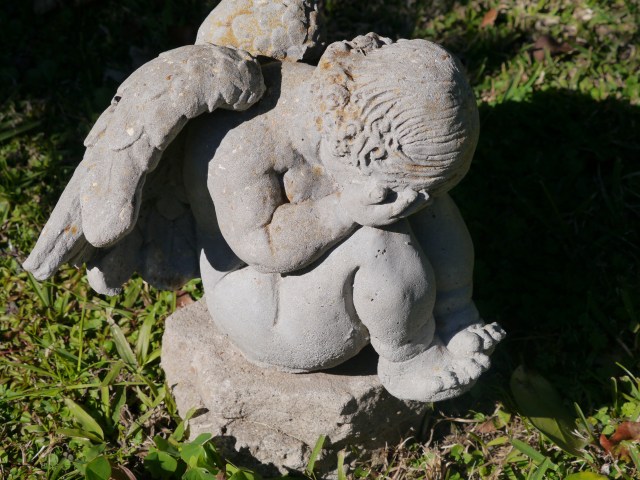
Photo by Keris Salmon
We were able to take a break from our seething and Instagramming when we arrived at Evergreen Plantation in Edgard, Louisiana. An active sugar plantation to this day, our tour guide walked us beneath canopies of 200-year-old oaks with low-hanging Spanish moss that resembled antique lace. We were walked through the “big house”— incidentally the same exterior used to film some scenes in Django Unchained. Particularly, one of my favorite scenes (I know) in which a slave woman asks of her master, “You want us to treat him [Django] like white folks?” I don’t know, that one just had me rolling — but I digress.
Burnt orange rooms with hardwood floors led us to marble hallways accented with wicker furniture sporting palm-patterned pillows. The rooms were tastefully designed with Victorian and Edwardian antiques that were perfectly preserved. We were told that our tour guide does not know the cost of upkeep on the meticulously kempt grounds because whatever it is it doesn’t matter: “The owners are oil heirs. This is just a hobby.” Quite a hobby.
We were walked to the slave quarters, some still standing, others restored. They were basic shacks, between three and five to a room. Although tiny, they were bigger than I thought they would be. We were told of the French colonial slave-keeping laws, which were apparently more humane than those of American, British or Spanish colonial laws. When we were told that the slaves were encouraged to be married, that young girls must be sold along with their mothers and kept from work until the age of fourteen, and eventually buried alongside their masters in the Catholic cemetery, we caught ourselves doing that raised-eyebrow, pompous nod of surprise until we were able to remind each other that these people, however less oppressed than their neighbors, were still fucking slaves. It seems that even back then, darker skinned folks were being handed a bone and told to be grateful for what they had.
When we arrived at the Dunleith Plantation in Natchez, Mississippi, it was almost dinnertime. We got properly soused on red wine, ate some food (I can’t recall what) and I fell face-first into my pillow, expecting to wake to a sprawling historical plantation much like Evergreen. One of the first things my mother’s boyfriend noticed upon waking up Thanksgiving Day, was that all of the rooms were named after prominent confederate soldiers. This information he bestowed upon us with didactic self-confidence. I was totally freaked, but he seemed more intrigued than horrified. How apropos that we spend Thanksgiving, arguably the most colonial holiday next to Columbus Day, in the most colonial environment in America. I couldn’t help but think that if indeed this particular plantation had any affiliation with actual confederate soldiers, that was creepy because the ghost of Stonewall Jackson was probably staking out my bedroom door with a sawed-off shotgun while I slept. And, if in fact, this plantation had nothing to do with the confederacy at all, then what the hell were the bed-and-breakfast owners doing naming the rooms in honor of the most racist blight on American history? I wanted to get out of there fast, but we were slated to enjoy Thanksgiving dinner on yet another nearby plantation and nothing was open at the moment so my only hope at eating anything that day was to wait it out, hangry as hell, refreshing my stupid Facebook feed until dinnertime. For the record, it turns out that neither of these places were actually plantations, but plantation-style homes. Nonetheless, they almost certainly employed a cadre of slaves, so the details don’t exactly sway me.
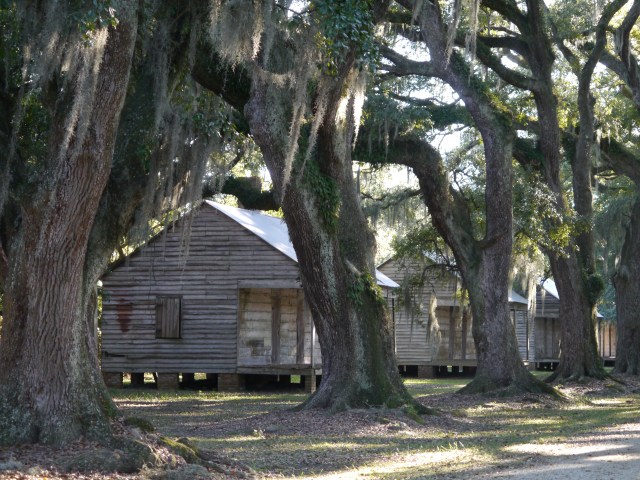
Photo by Keris Salmon
The next morning, as my mother and her boyfriend ate their breakfast, they approached a couple that had been sitting next to us at dinner the night before. They looked nice enough: older, white, kind of edgy looking. The dude had a kind of Keith Richards thing going on. My mom asked how their dinner was. They said it was fine, and remarked how we were being kind of “rowdy,” most likely referring to our umpteenth heated discussion of the events in Ferguson. And then he asked my Black mother and her white boyfriend, “so… uh, how in the world did you two get hooked up???” My mother, bless her heart, tried with every cell in her brain to rationalize this question. She thought, “maybe he thought I was wearing whacky clothes, and Frank dresses so conservatively.” She does dress very colorfully (pun not intended). But the rest of us took it for what it was, even Frank. And after so many days of suppressed mania, a wave of exhaustion washed over me. The nail in the coffin was when I called my 98-year-old grandmother from the car on our way back to New Orleans. She said, “I just… cannot believe y’all are in Mississippi. Although, I guess times have changed a bit.” Yeah, grandma. A bit.
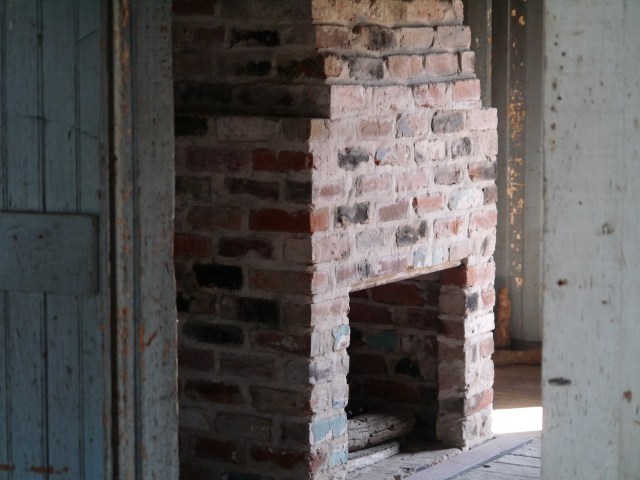
Photo by Keris Salmon
Two days after returning to New York, the cop who murdered Eric Garner was absolved of any indictment. But instead of rage, or anxiety, I felt tired. Tired from travel, perhaps, but also just wiped. Worn down by the concurrent weight of history unraveling behind me and the present unfolding before me, I felt paralyzed. History is repeating itself too soon, it seems. It’s déjà vu all over again, and the only tools we have to address it are our voices. That weekend, I was in the streets, but not to rage or burn. I was there to mourn, or rather, to wait. Because at this stage of grief, my only burning and desperate question is: Are we there yet?
“This Shit Has Got to Change”: The Autostraddle Interview with Black Lesbian Feminist Legend Barbara Smith
This past Saturday, just a few hours before the Millions March in NYC, I sat down with a Black lesbian feminist legend, Barbara Smith. Barbara was a co-author of the Combahee River Collective Statement, alongside outspoken Black feminists like Audre Lorde and Chirlane McCray (who is now married to NYC Mayor Bill DeBlasio). She is a writer, activist, community organizer, and served two terms on the city council in Albany. She and her colleagues developed the concept of identity politics, a predecessor to what we know today as “intersectionality,” a term later coined by Kimberle Crenshaw. Most recently, she has released a book called Ain’t Gonna Let Nobody Turn Me Around: 40 Years of Movement Building, which juxtaposes historical documents alongside interviews with activists and scholars to craft the narrative of a Black lesbian feminist who has dedicated her life to wholly inclusive movement building.
As I tried to figure out what kind of outfit transitions well from serious interview to protest, Ms. Smith was killing it on the Melissa Harris Perry show, and approximately 60,000 people began gathering around Washington Square Park to speak out against police terror on Black bodies. But I wondered, how does Barbara feel knowing that this movement seems to be focused primarily on the Black male lives that are taken by police violence? Does she see Black and brown women missing from this narrative? Does she see room to promote an intersectional approach in a movement that seems to be growing like wildfire? As a young person, I am always curious to know what older generations see when they look at enthusiastic young people. I wonder how our moments compare to their moments. Do they see progress, or do they see a nation of apathetic hipsters who attend protests to have their picture taken? I sincerely hoped it would be the former.
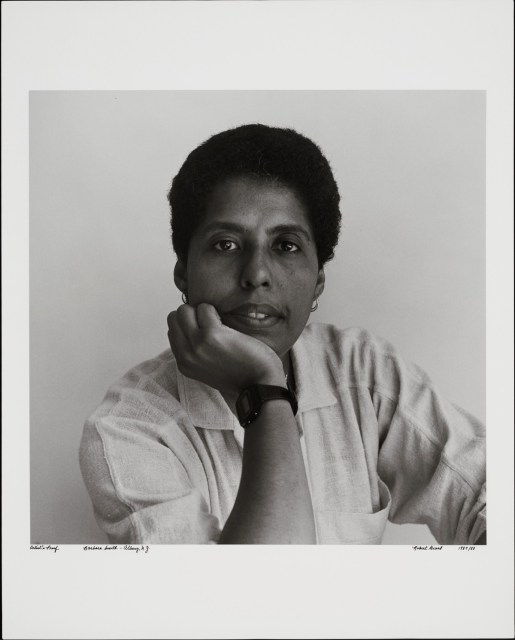
Photo by Robert Giard Papers via the Yale University Archives (1987-88)
I feel like a lot of young folks of color, especially queer women, don’t have as difficult a time understanding intersectionality, just because they live it in their bodies every day and… it almost seems as though compartmentalizing identities is more difficult than understanding them as intersecting. I’m wondering how you, as a Black lesbian, came to develop the language for identity politics at a time when I feel like there were few words for understanding identity by complicating it rather than simplifying it.
When we started trying to develop these politics the term “intersectionality” was not used… We talked about “interlocking oppressions” and we talked about “the simultaneity of oppressions.” This wasn’t just in the Combahee River Collective statement, but it was also in other places, like in our conversations and other things that we might be writing or thinking. But how it came about is that we were just examining our situation, and saying, you know, “Black politics, male-defined, is not going to get it for us. A white, bourgeois politics isn’t going to get it for us. We need to have all the parts of who we are to be incorporated into our political agendas and our political work.”
I came out only a few years after Stonewall, relatively speaking — the mid-70s is only a few years after Stonewall — and fortunately I was in Boston at the time… There was a really radical sector of the lesbian and gay movement, and a big outpost of that more radical and leftist lesbian and gay movement was in Boston. There’s a wonderful publication called Gay Community News… GCN was just an incredible publication, they published for many years, and unlike most gay publications, most women’s publications, they actually covered racial issues and class issues and sex radical kind of issues, so, that was kind of like a “part of our crowd” so to speak. So we were surrounded by really insightful, very very courageous people. And the cross-pollination of all that kind of iconoclasm, in-your-face-ism, whatever you want to call it, that helped us too… the bottom line is we examined the situation we found ourselves in and said, “this shit has got to change.”
This is kind of a serendipitous day to do this interview of course, with the Millions March in D.C. and Albany, where you’re going back to, and in NY… in two hours, I think? Do you feel like your life’s work is coming to a head or is this sort of just another wave of many waves?
Well, my life’s work is far from done! The thing is that I do really see the kind of organizing that people are doing around these issues — police brutality, racism, etc. — that there’s a much greater willingness from people on all ends of this current form of organizing to be more inclusive. As you know I was just on the Melissa Harris Perry show this morning… and we were talking about how there are women and LGBT people who absolutely are respected and seen as leaders. To me that’s just really exciting. I think that the work that we did in the 70s has been available to people long enough now that you actually have like a third generation. Because my generation of activists and scholars and theorists and etc., we’re like senior citizens now… So as I said, there’s been a chance for some of those ideas to take, perhaps, a deeper root. One of my frustrations is that often, young people don’t know where the ideas came from. That’s one of the reasons why I’m happy that this book is out! Because I hope that more people will get to look at the history and say, “Ohh, really? They were talking about that back then? That’s really interesting!”
That was going to be my next question, is whether you feel as though people are using the lessons from past generations. And to ask you what it’s like to watch the movement transition from one generation to the next? I’m sure that it can be frustrating sometimes. Especially with this particular movement gaining so much traction, and so many people. It can be sort of difficult to make those lessons known to such a large contingency.
Yeah, I mean unless you have your own television network or like the New York Times or the LA Times — ’cause newspapers unfortunately have fallen on very difficult times as far as circulation goes — but unless you have a major media outlet, it’s very hard to get your ideas out. Except now we have the internet and social media. It’s really not about: does every single person down in Washington or every single person who will be here in NYC later today, demonstrating, are they aware? But there’s some key communication that’s going. And I never get that frustrated by organizing — unless organizing leaves people out. That’s when I get frustrated. But if organizing is inclusive, and has the mind of connection and respect for people wherever they are, and whoever they are, if that’s happening then I feel good. And also, I always feel good when people “speak truth to power,” and do what needs to be done, so…
And you feel as though this is really including everybody? Because sometimes I feel as though it can be hard for people to show up to marches, and it feels like a lot of this is focused on showing up, blocking traffic and that can be difficult for people who are physically unable to attend.
Mmhmm, or have a job, or have several children… Or are homeless. Exactly… I don’t know if the success of organizing or activism is around pulling people in or away from the responsibilities or challenges of their daily lives. One of the things that made the civil rights movement so unique is that it was a poor peoples movement, and that’s one of the thousand reasons that I love the civil rights movement. It was the first movement I was ever involved in. And, because it was poor Black people, primarily southern, it had a set of values and an inclusiveness that has been unique… There’s the concept that was talked about at the time of the “beloved community.” That’s always something that you’re striving for. Y’know you never quite get there if you’re an actual organizer or activist because you know there’s more around the bend… The farm workers movement was unique, and still is because it does indeed organize people who don’t have class or white skinned privilege around the things that are most pressing for them. Some of the other movements, like the women’s movement, the mainstream women’s movement: not so much, because it was often white women with access to privilege who were well educated, very intelligent, and bored out of their skulls doing the little wife routine, or the little woman routine. That was different.
https://www.youtube.com/watch?v=TJqbp3OGhCo
So you’ve talked about your connection to your southern roots. And my oldest living relative is my great grandmother Evelyn who is 98. She’s from Valdosta, Georgia.
Wow! My people are from Georgia!
I read that! She migrated here to New York when she was a baby. Her parents brought her here. So I’ve been sort of trying to mine her experience for my own edification.
So her parents came during the first migration, between WWI and WWII, given her age.
Yes.
Cause 98, yes, so they came very early. My family came during the first migration to Cleveland. So they came after WWI and before WWII.
And she seems very focused on remembering the good times, y’know, going to dance halls and that’s totally her prerogative! She’s 98 years old, she can do whatever she wants! I guess I wanted to know what your experience has been mining that experience of your relatives and your connection to your Black southern roots and what has stuck with you the most.
Most of the people I grew up with were deceased by the time I was in my mid-late 20s, almost all of them. Starting with my mother who died when I was nine years old. So, the thing is that I have never really had a chance to have the kind of conversations that you and so many other people who are very sharp have with their older family members, because by the time I had the brains to know that was something I would love to do, they were gone… I often say that one of the reasons I’m so involved — there are many reasons — but one of the reasons I am drawn to Black studies… and Black literature and other related Black disciplines is because it’s a way of finding out about my past and my family’s past even though I can’t specifically ask them questions. I can have a general overview, like for example finding out that Georgia was probably the second worst state as far as lynchings after Mississippi… Have you ever heard the Nina Simon song “Mississippi, Goddam”?
I love that song.
Love it. Love it love it. And of course I was around when it came out. We loved that song. And it’s so hysterical because the style of the song is like it’s from a musical, and she says “This is a song from a musical but the musical hasn’t been written yet.” But it’s just so bouncy and so cute. And yet, It’s Mississippi, goddamn…
I do remember my aunt whose name was LaRue she talked about like when she was getting ready to come up to Cleveland. So she was a teenager… Where they lived there was a white man who I think owned a store and he was sitting on the porch… and she’s going by and he says to her y’know “LaRue, you don’t need to go up there. You don’t need to go up north.” It was threatening! And I just think what did this young Black woman, a teenager, what did she think? … She’s living in Georgia in the early 1900s where they’re lynching people every five minutes!… And then my uncle, who was a mechanic, which is a very good job for a Black man at the time, he was an auto mechanic… also talked about how, when he left they put him on a bus…. And basically sent him up north so that he would be alive. Now I don’t know what had happened. But the thing is he didn’t want to go, but the way he put it was “they made me leave, because they were afraid for what might happen.”
On the topic of ancestry, my maternal grandfather’s alma mater was Lincoln University, which recently had a little controversy.
Well at least they fired his behind.
Did they? I’m so glad.
Well he left… but I assume they would have fired him if he hadn’t left, so…
I’m wondering, you know, it’s an educational institution, it’s an historically Black college, that has historically had a really good repuation…
Langston Hughes.
And I think now it’s more of a sports college… but how does that kind of intersectional approach completely sort of go over their heads in places where we’re supposed to be educating people of color?
Right, well white colleges and universities are not doing very well around sexual assault and sexual violence either. So, I think that, and I’ve often said this about people in the Black community who express really backwards statements… particularly around homophobia, is that Black people will tell you, you know what I’m saying? We have a very expressive culture. We have a very oral culture: Hip hop, rap, you name it, poetry… we just talk. And talking is very much valued in Black culture. Being truthful…
“Keeping it real.”
That’s why my book is called “The Truth That Never Hurts,” cause I was just trying to draw that, or play with that… The difference between a white person who has a similar or the same point of view as that Black president from Lincoln [is] he was just stupid enough to say what he thought out loud.
On the same topic of colleges: The whole Rolling Stone interview with the UVA student and the backpedaling that’s happened since then… What are ways, do you think, that people can approach that story and that narrative to keep the conversation about campus sexual assault alive while admitting that bad journalism is bad journalism?
Uh-huh, that is one of the major lessons from that. I saw the writer, Sabrina Rubin Erdely, the week before. What she did not do came back to haunt her. I was struck by how very very passionately committed she was to this issue. She presented very well. I listen to what people who are familiar with the situation say. People who are around the survivor say that they believe that something terrible happened to her. That’s what I focus on. I think something terrible did happen to her. The fact that the journalist did not do her due diligence and get the perspective and interviews with people from the other side: that is a horrible situation for that to have been the case, because often people don’t believe women anyway.
We have systems that are broken. Even when errors or mistakes are made doesn’t mean we don’t have a problem with sexual assault. In fact the president of UVA, she is saying exactly that. She is saying that even though this may not be exactly as originally presented, [they] are still going to deal with the issue of sexual assault on [their] campus.
Changing gears: I feel like more often than not problems in communities of color are framed as “men’s issues.” So, whether it is absentee fatherhood, Black on Black crime, or just the idea…
Or even the police brutality and the murders that are happening…
How do you think that can be addressed? The police violence that women face is so much more behind the scenes.
Oh yeah, it often involves sexual assault and rape… That’s true for trans women as well… The part that has been done to address it has been building a Black feminist and feminist of color movement for the last 40 plus years. That’s what been done to address it… I have real issues with the notion that Black men are endangered and Black women are living the life of royalty and having a wonderful experience. It is not accurate in any way shape or form. I am not trying to pit one group against the other… What I am saying is, just look at what’s around you. Look at what’s really happening in our neighborhoods and in our homes and in our institutions and communities as opposed to the PR or whatever… Don’t just look at what the spin is about. Here is a perfect example: in Schenectady — one the upstate cities in the capital region where Albany is — Schenectady I believe it was, five young Black women teenagers, high school students, all of them committed suicide within a short period of time with great proximity to each other. I may have the number incorrect but it was like 4 or 5. The reason that they committed suicide: there was bullying and harassment going on… It was directly related to this sexual violence and domestic violence they were experiencing and to the gang mentality and gang rites of passage they were subjected to. That’s real. That happened.
Another example out of my own organizing experience was when 11 or 12 Black women were murdered in Boston in a 3 month period in 1979. We did everything we possibly could to make the connection between violence against women and racist violence because Boston — I’m sure to this day but certainly in the 1970’s during the school busing crisis — [there was] a huge amount of racial violence and a huge amount of racial conflict. In the 70s racial violence was on everybody’s mind who cared about those things. The thing was, that was all Black women who were murdered. Why was it all Black women?
I lived in Roxbury. I lived in two different neighborhoods when I lived in Boston… The first neighborhood I lived in was the South End, which is now almost completely gentrified but I lived there in the early 70s… Then I was gentrified out of the South End and I moved to Roxbury which is like Harlem.
I would go to the subway in Boston the nearest stop near my home and I saw a KKK graffiti on my walk to the subway. Where am I going when I am getting on the subway? Most often and most likely I was going down to Back Bay to teach at Emerson College because that is one of the things I was doing in those years. I was teaching at Emerson and also taught at UMass Boston. Here I am, this graduate student, but already teaching — clearly committed to something positive — on my way to teach Black Literature to my wonderful students and I’m looking at KKK graffiti. The point I’m making it wasn’t off or inaccurate to look at those murders initially as racial crimes but it was all women…
One of the things that a Black woman said — I can’t remember who, one of the great thinkers — what she said, and I never forgot it, “Black men explode and Black women implode.”
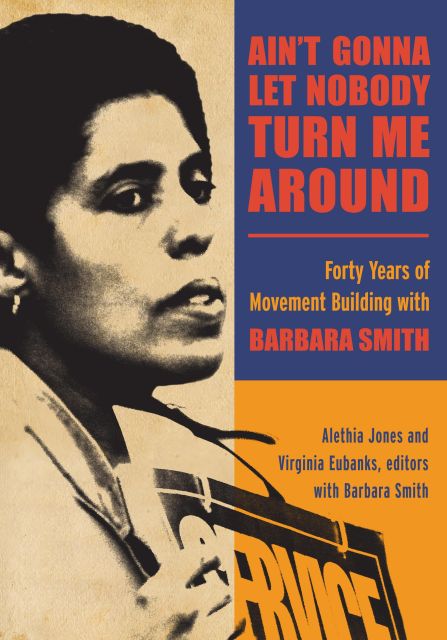
Ain’t Gonna Let Nobody Turn Me Around: 40 Years of Movement Building with Barbara Smith is edited by Alethia Jones and Virginia Eubanks. Available for purchase on Amazon and bookstores near you.
This interview has been edited for clarity.
This Shit Rules: Moisture For Your Ashy Bits
Welcome to This Shit Rules, wherein members of the Autostraddle team open up to you about the beauty products they couldn’t live without.
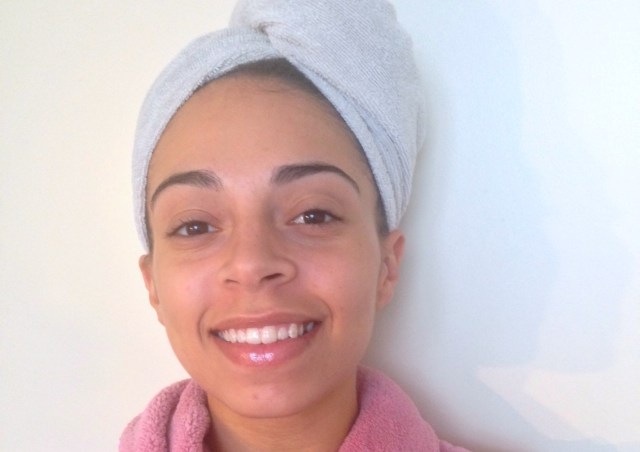
probably the least make-up you’ll ever catch me wearing.
Yes, winter is indeed coming, and for most people that means chapped lips and rosy cheeks. For those of us designed for warmer climates, however, it means blasting the heat all night and waking up from night terrors about fire ants attacking your legs (which, for the record, is preferable to waking up with nipples cold enough to cut glass. I have never found a happy medium). My knees look like I’ve been crawling around in the fireplace. My lips are so dry you could peel off a layer and roll a joint in it. I’m itchy as hell y’all, but thankfully, I have an arsenal of products to keep me whet as a whistle.
Vaseline Lip Therapy with Aloe Vera
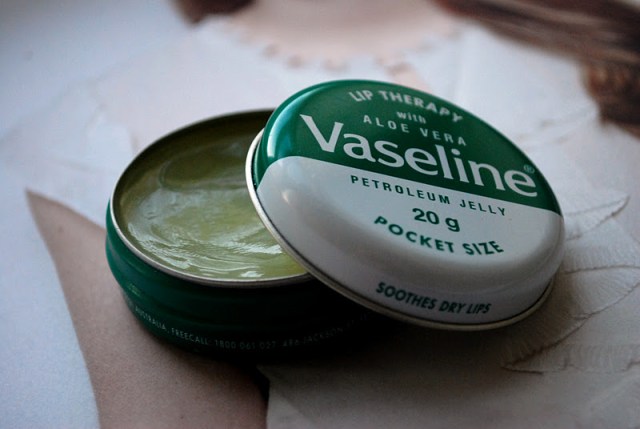
via anna elisabeth
People have mixed feelings about putting petroleum jelly on their lips, but whatever they do to this lip jelly (that is for whatever reason only available in Europe), is magic. It also comes in plain and rosewater flavors, and I use it under my eyes when I run out of eye cream.
Buy It on Amazon: 0.7 oz, pack of two ($5.08)
Life-flo Pure Almond Oil
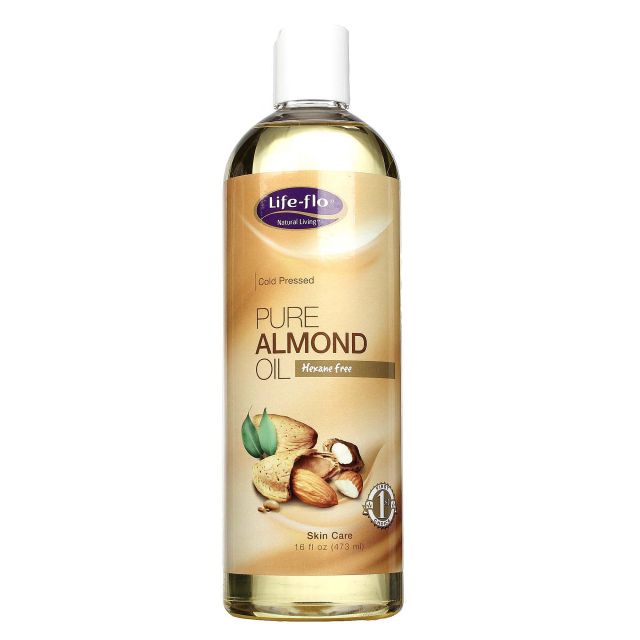
via evitamins
For days when your skin feels too small for your face and regular face cream just won’t cut it, organic cold-pressed sweet almond oil should do the trick. Use this oil after washing your face and applying whatever other anti-acne/anti-aging/anti-gravity creams you may want to use. WARNING: Use only ONE DROP. This stuff means business, and by business I mean it will leave an oil slick across your face if you use too much. ONE. SINGULAR. DROP. It goes a long way.
Buy It on Amazon: 16 oz. ($10.46)
Aveeno Skin Relief Moisturizing Lotion
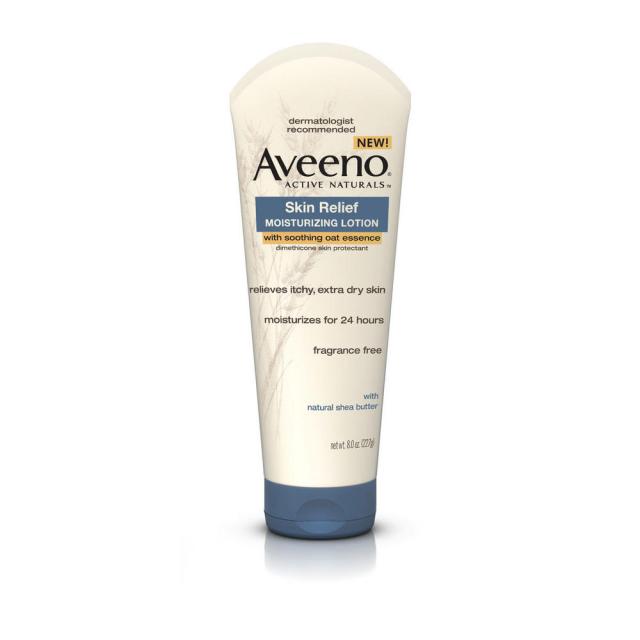
via Aveeno
So normally I just slather on some coconut oil right out of the shower, but this shit really rules. I actually don’t own it. I just steal it from my mom when I’m home. It’s got “soothing oat essence” and shea butter, and a little bit of magic sauce that’ll take the bite out of frostbite.
Buy It on Amazon: Pack of 3 8 oz. bottles ($25.73)

